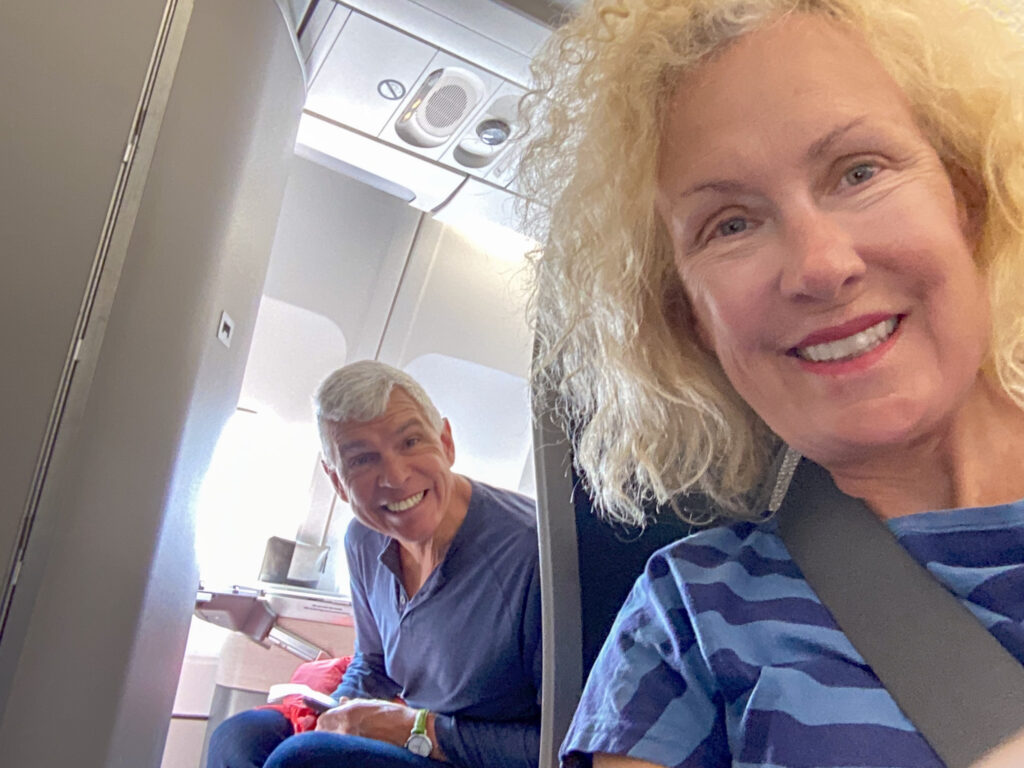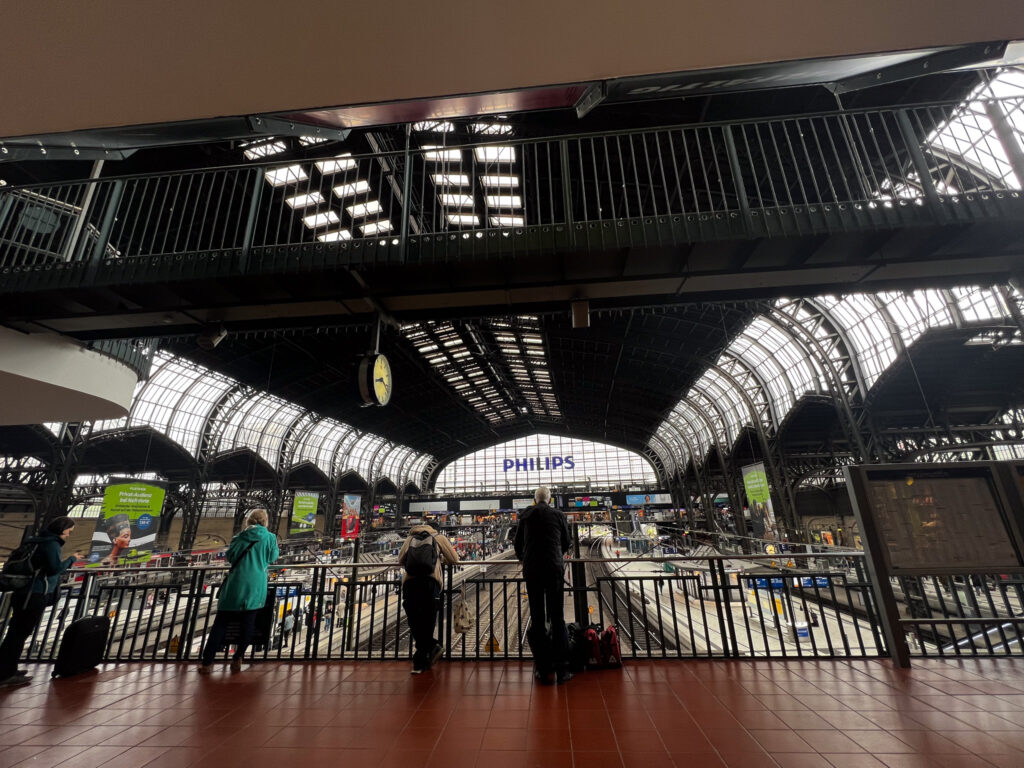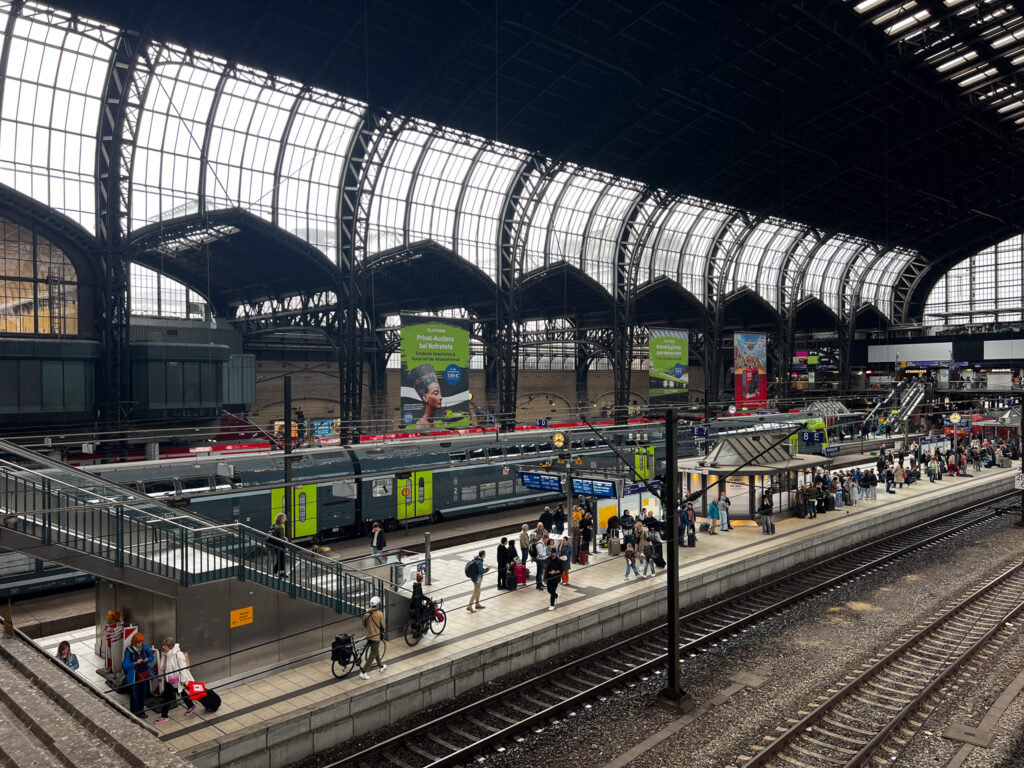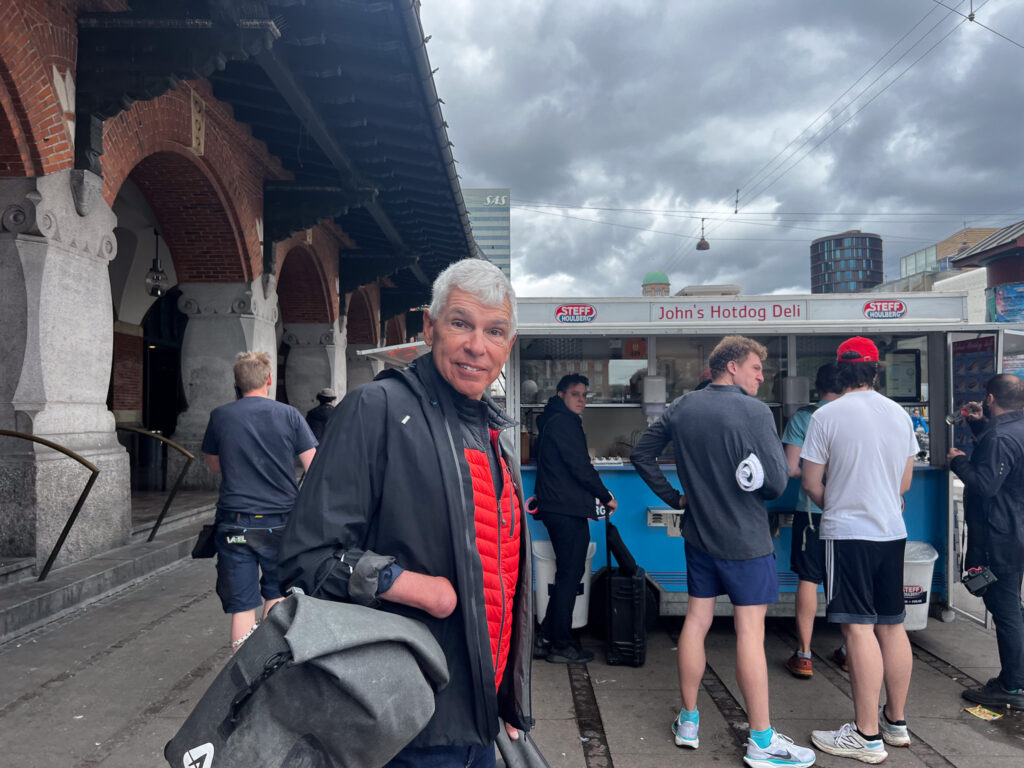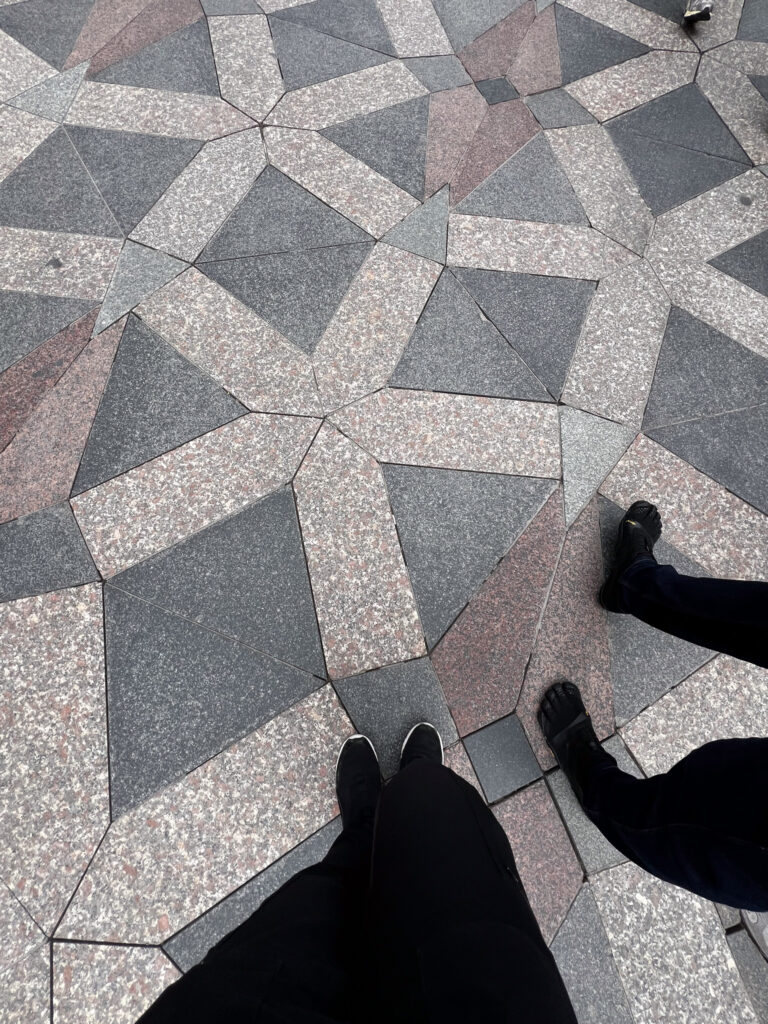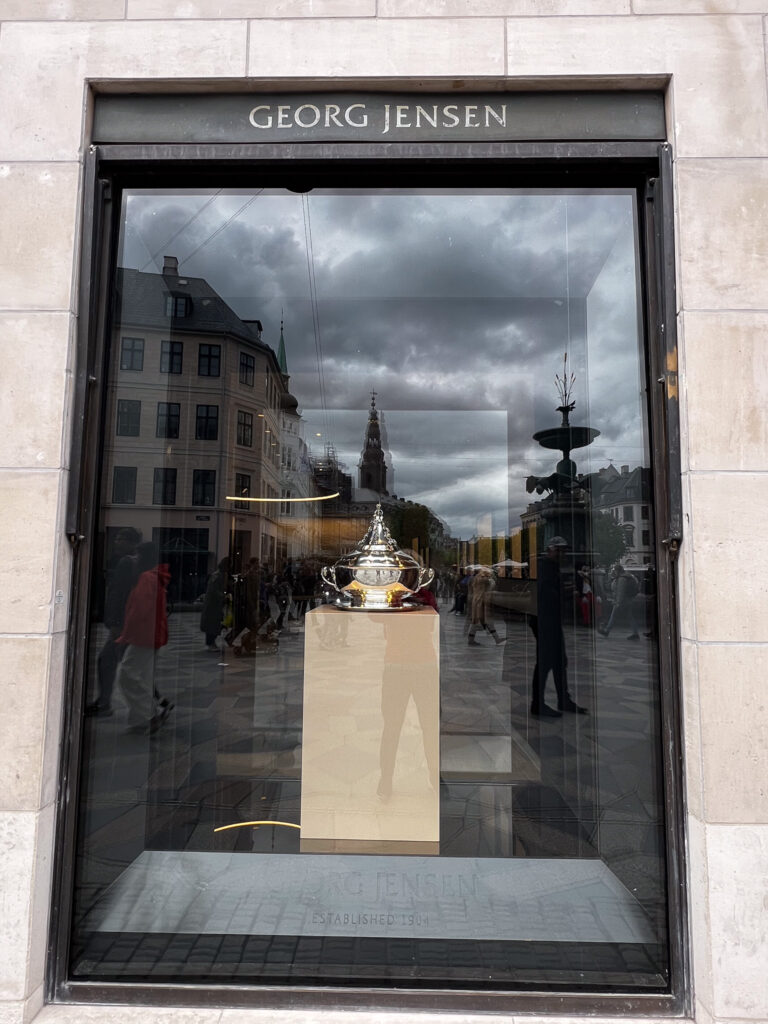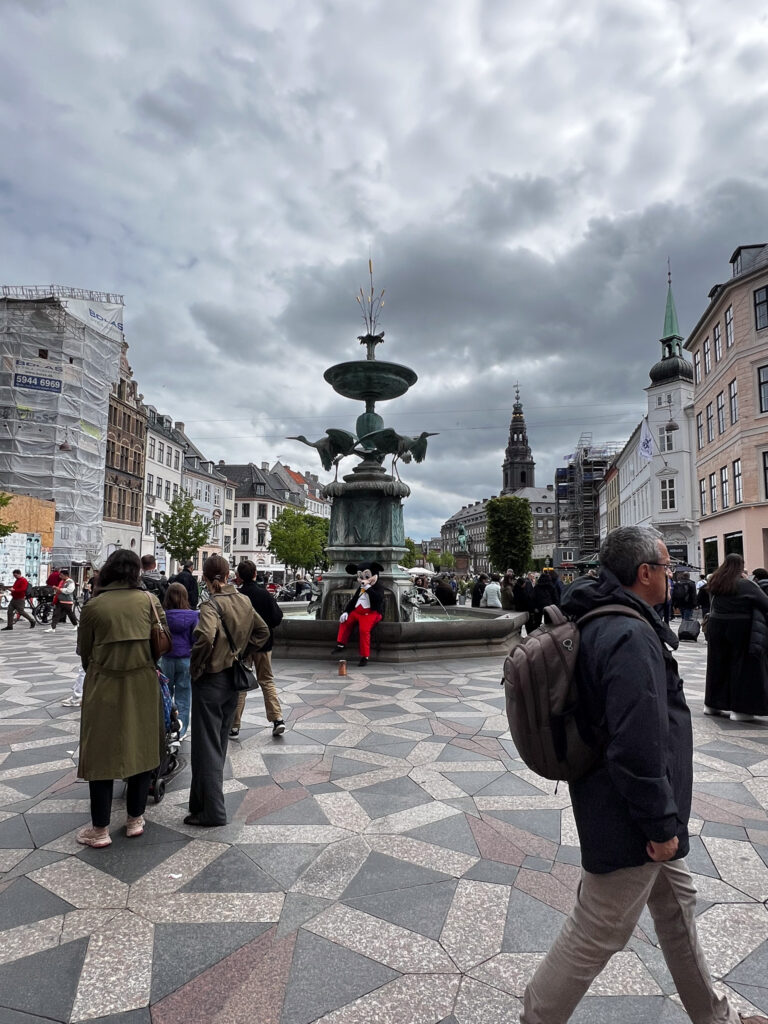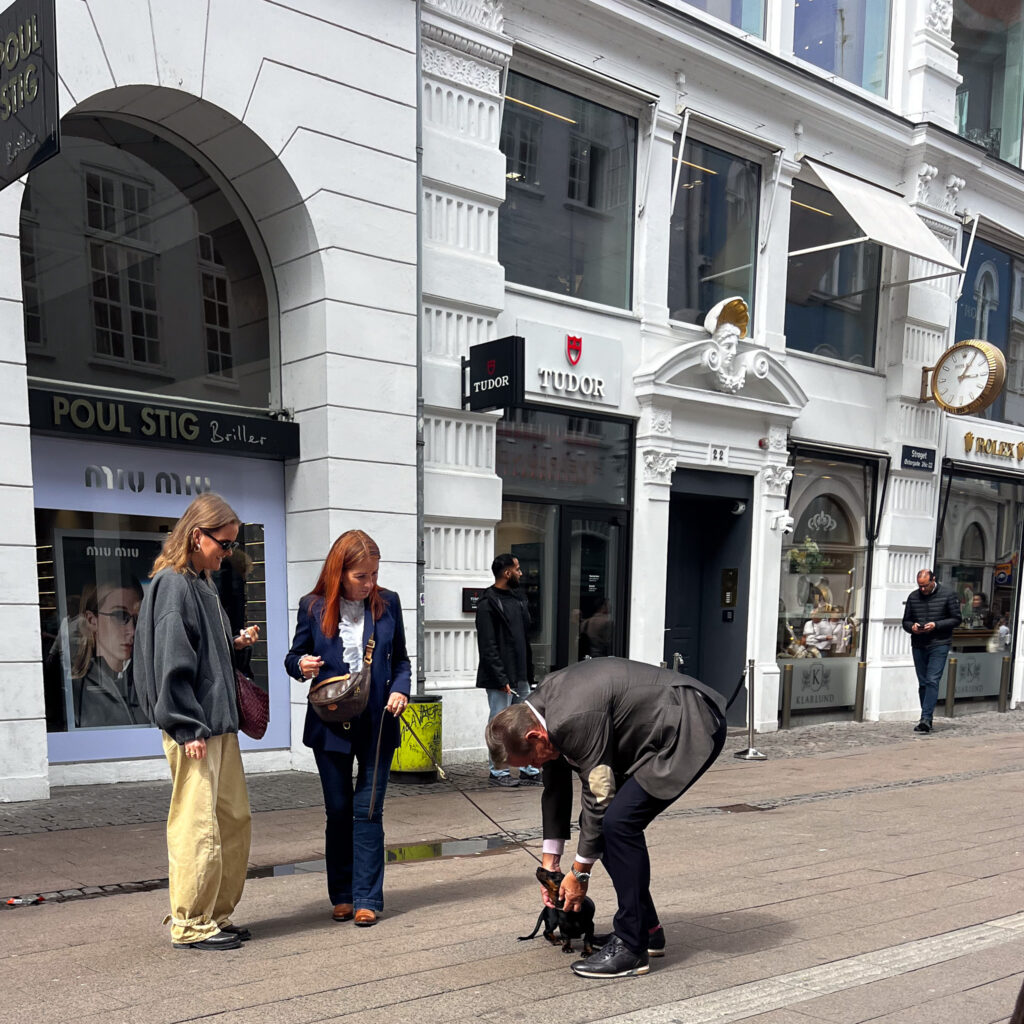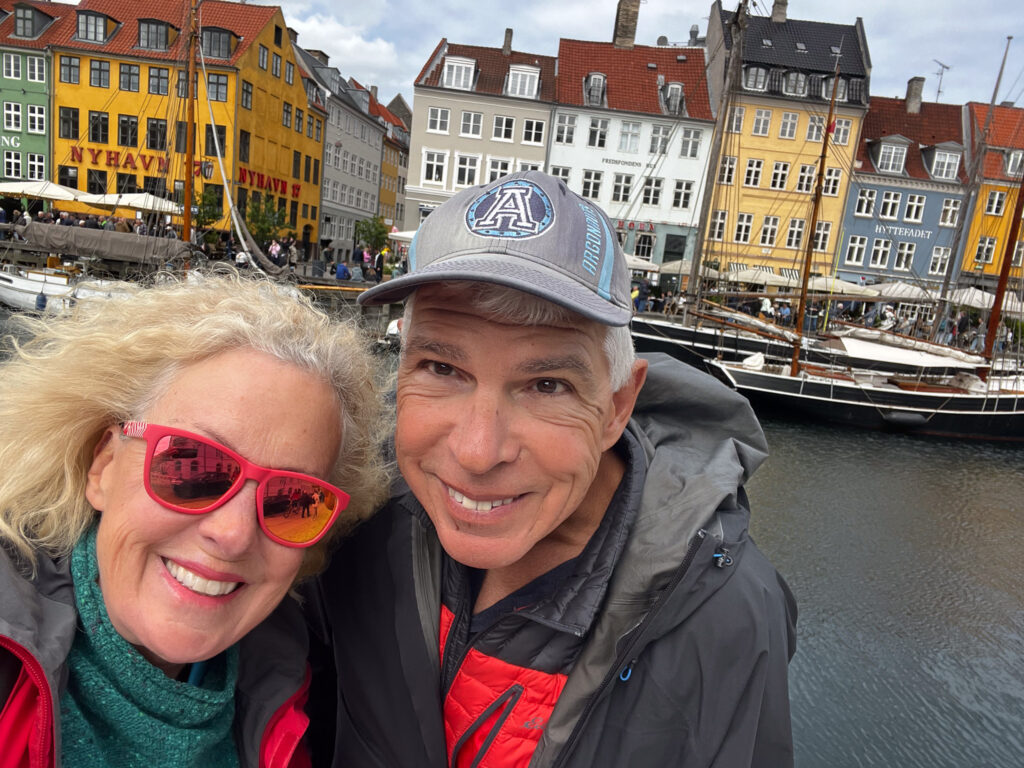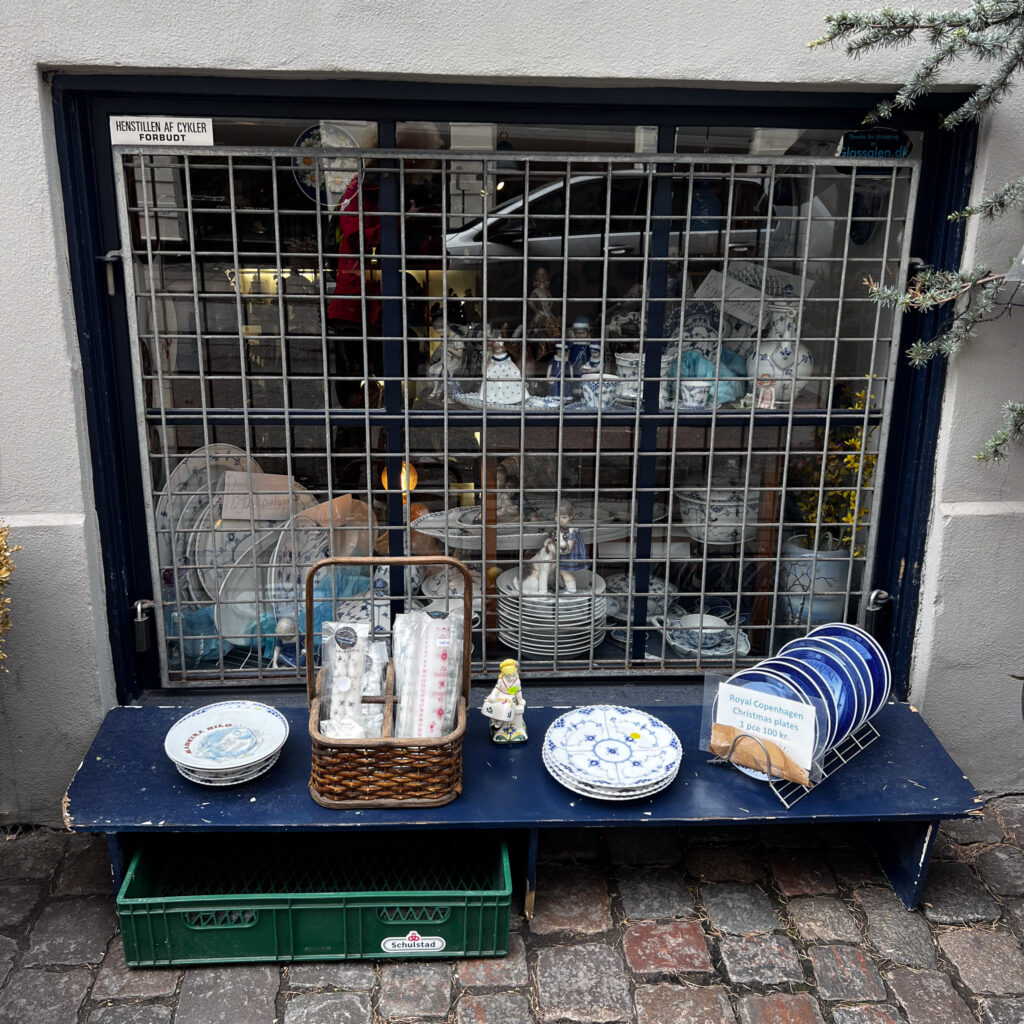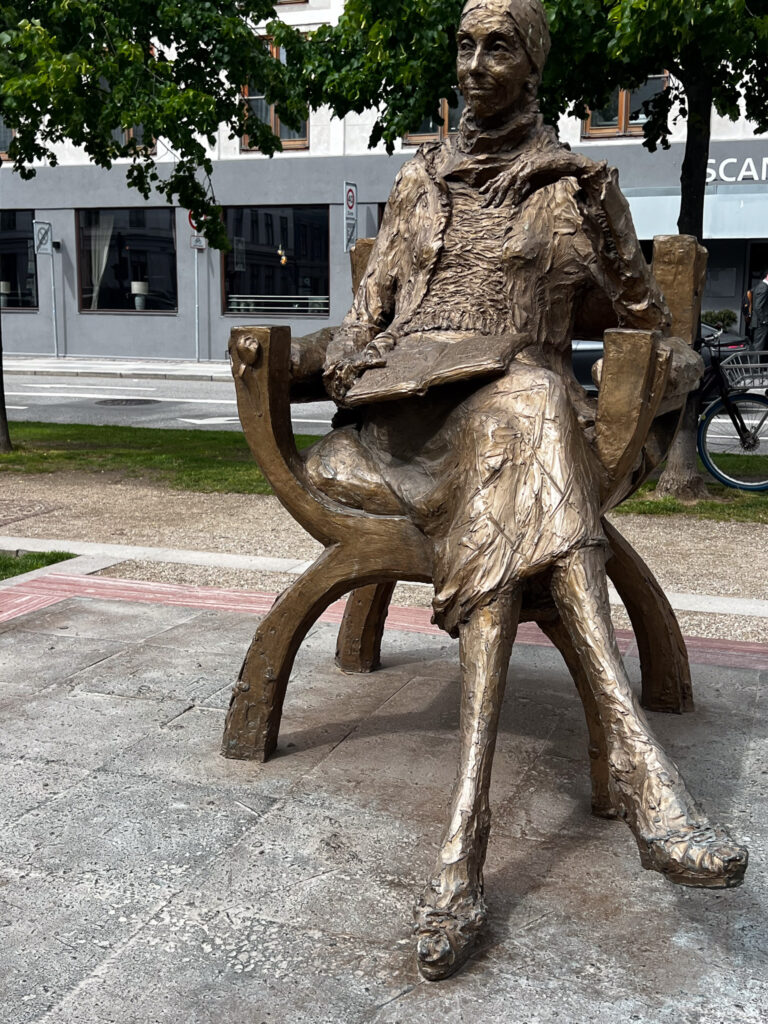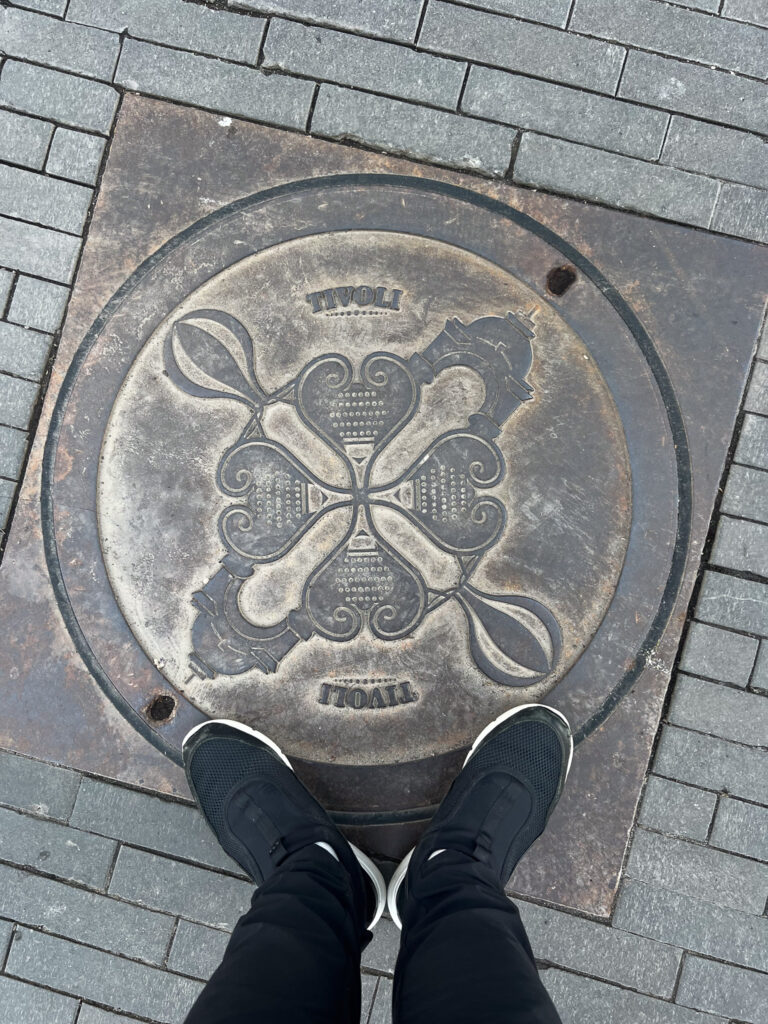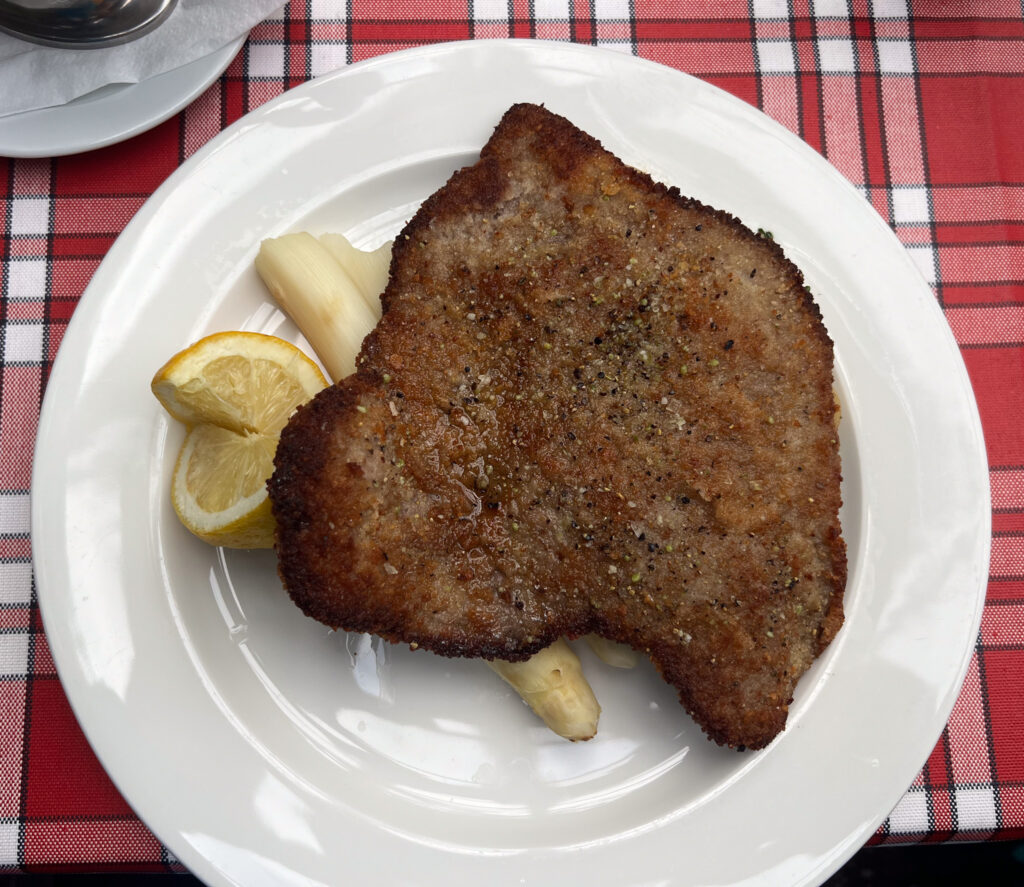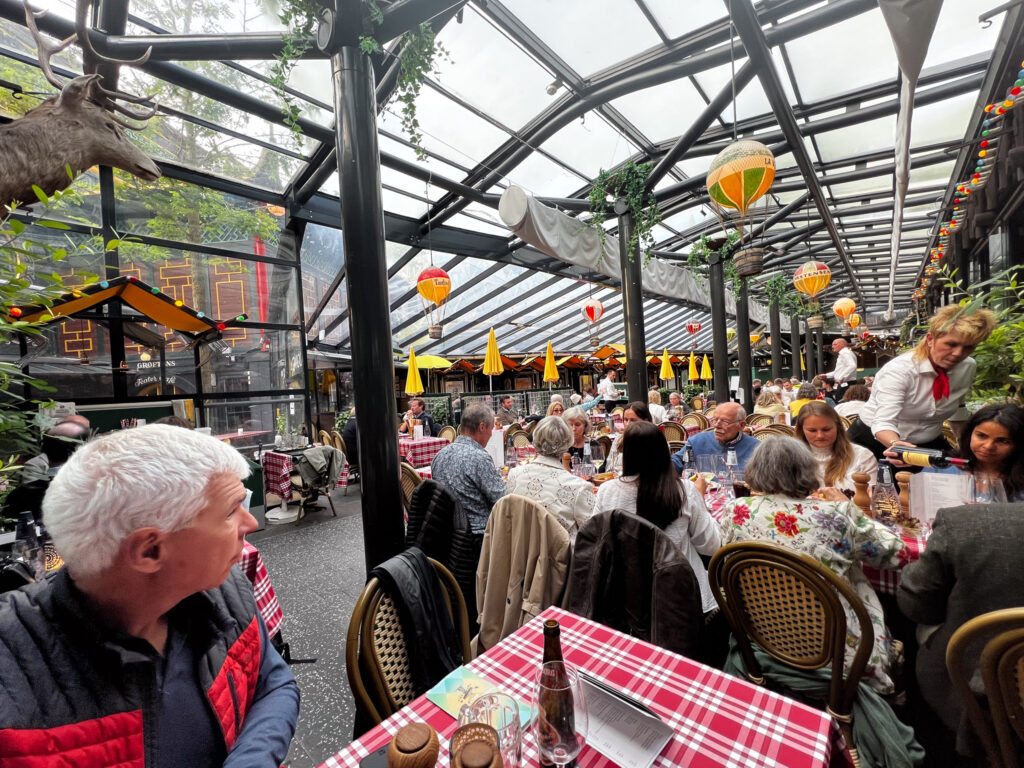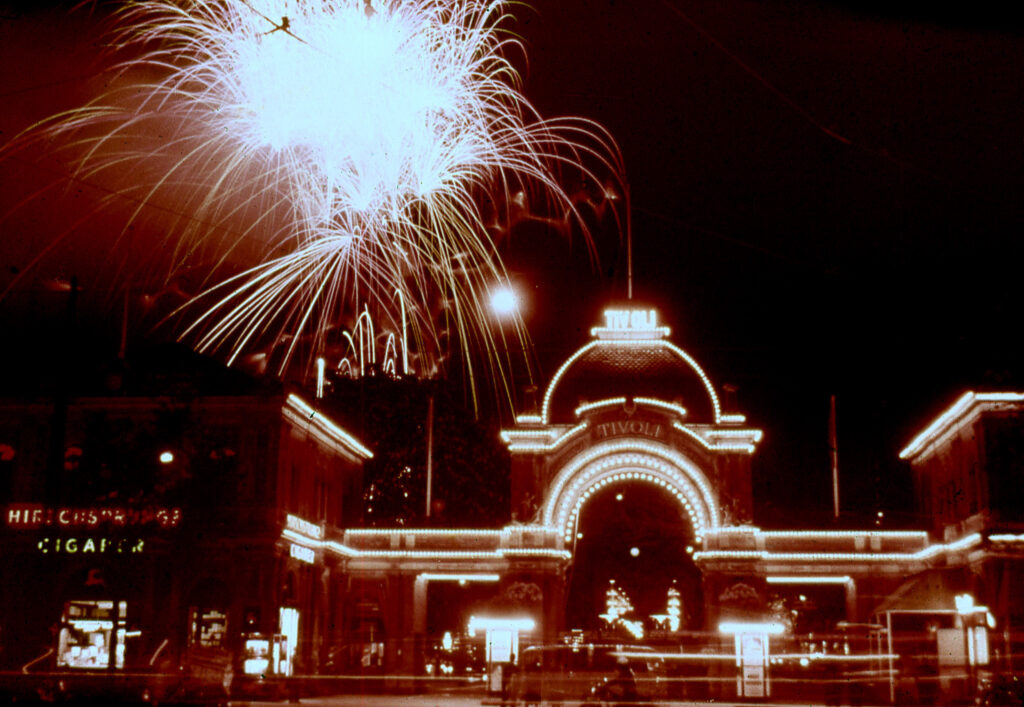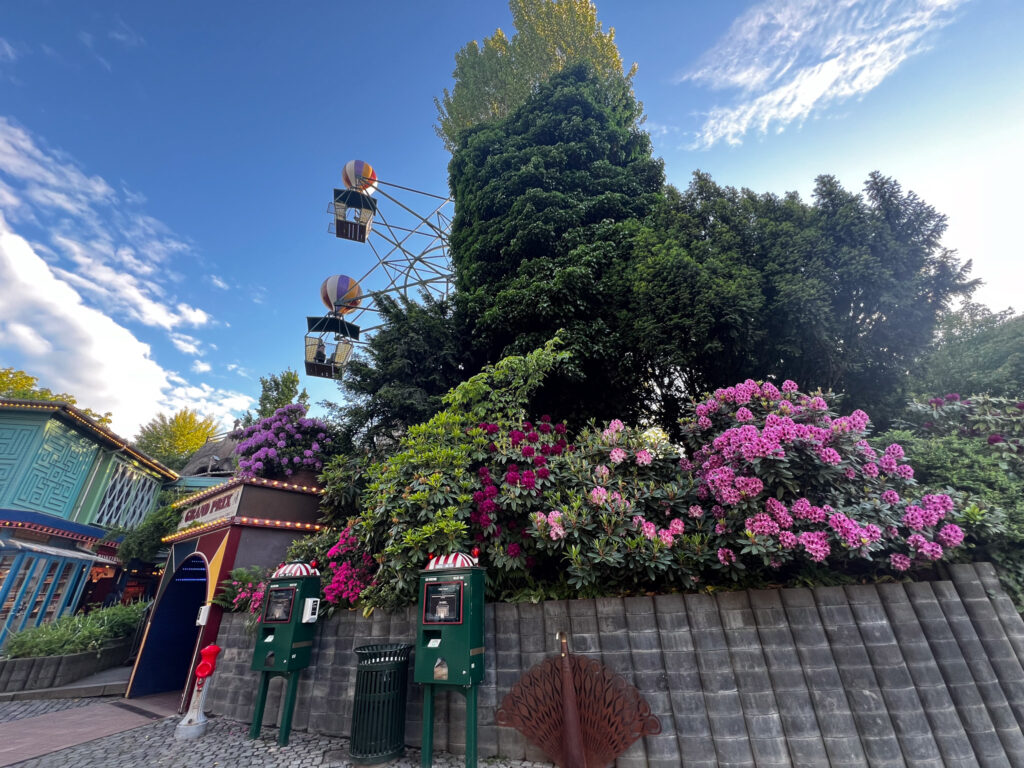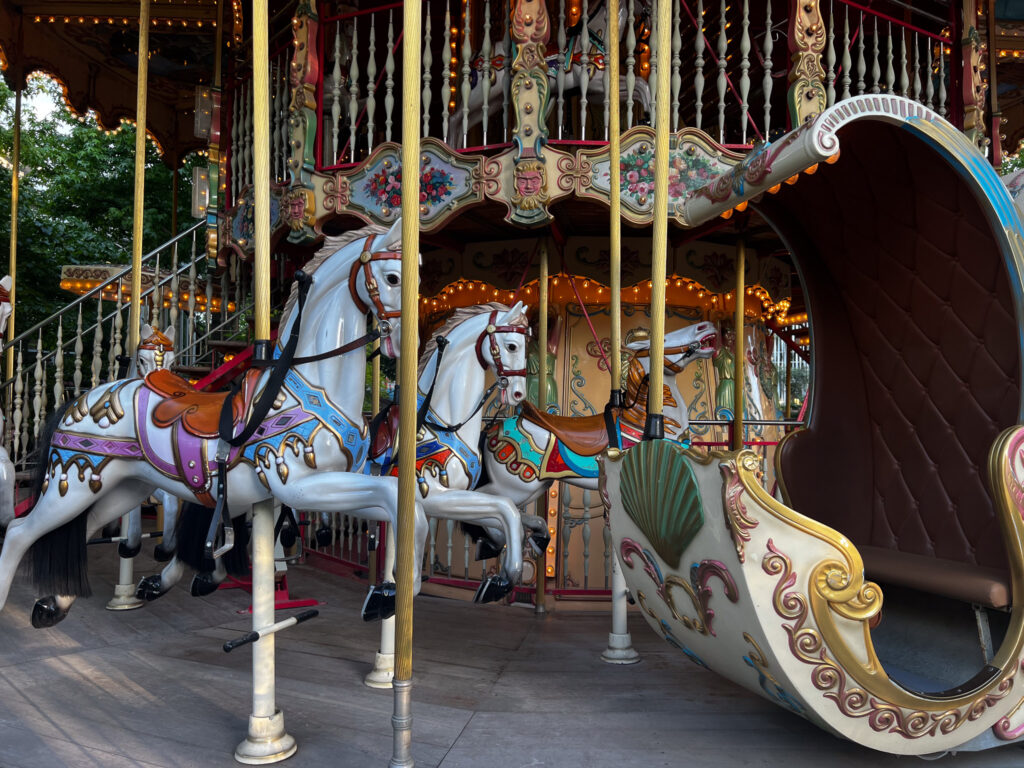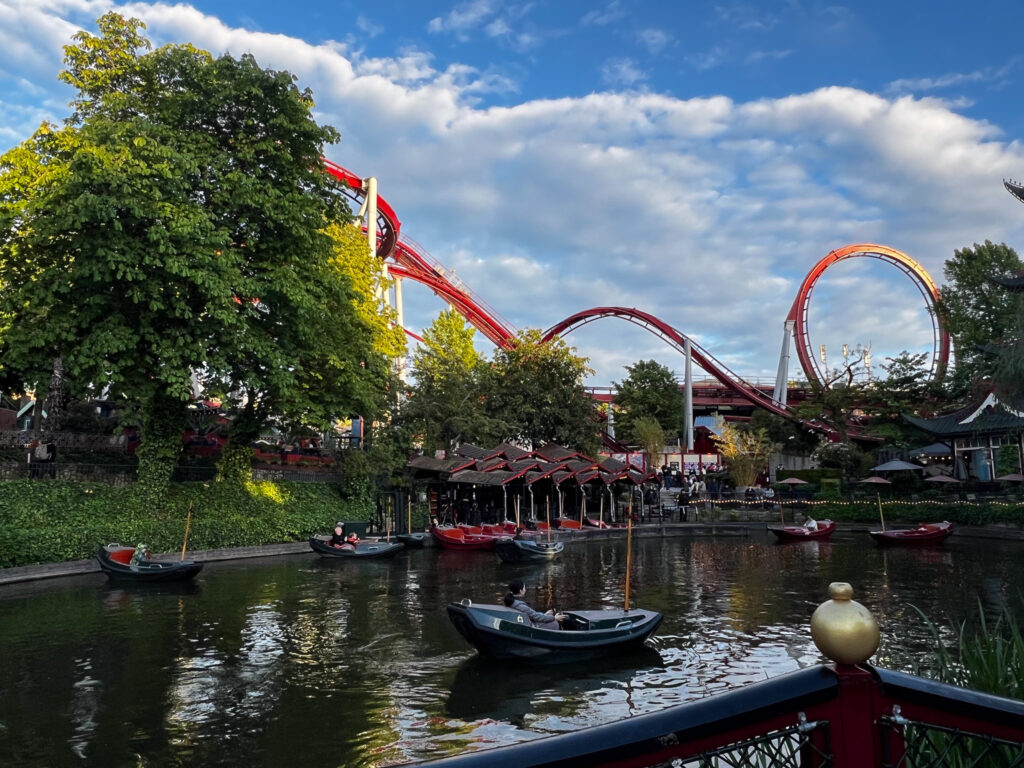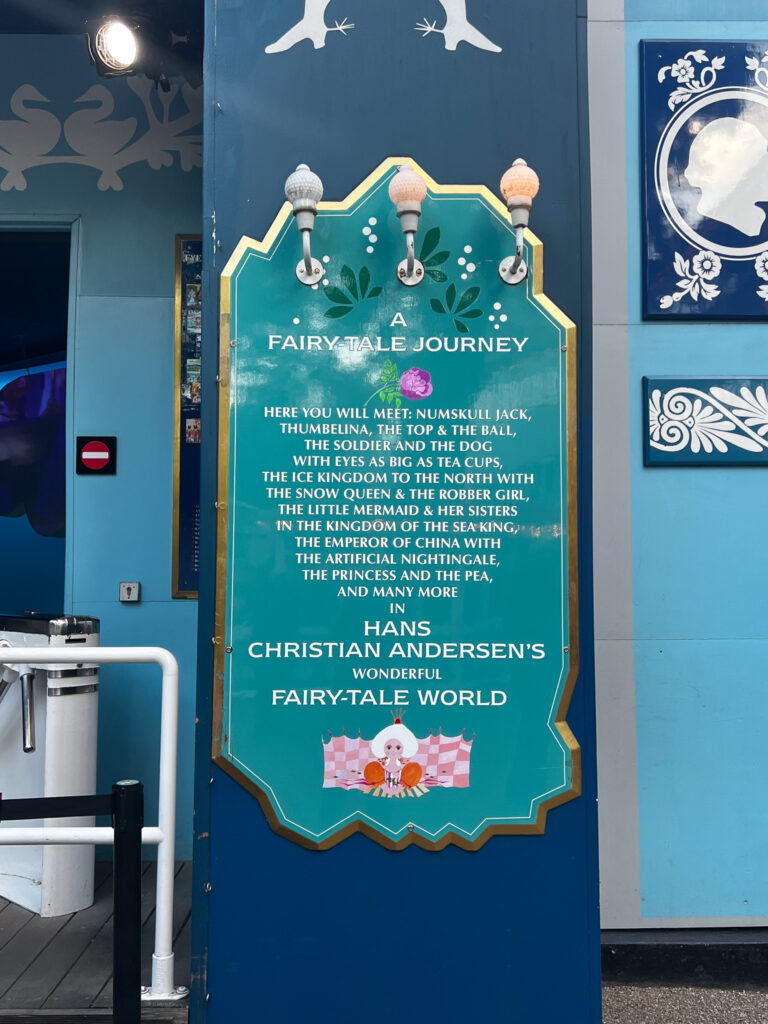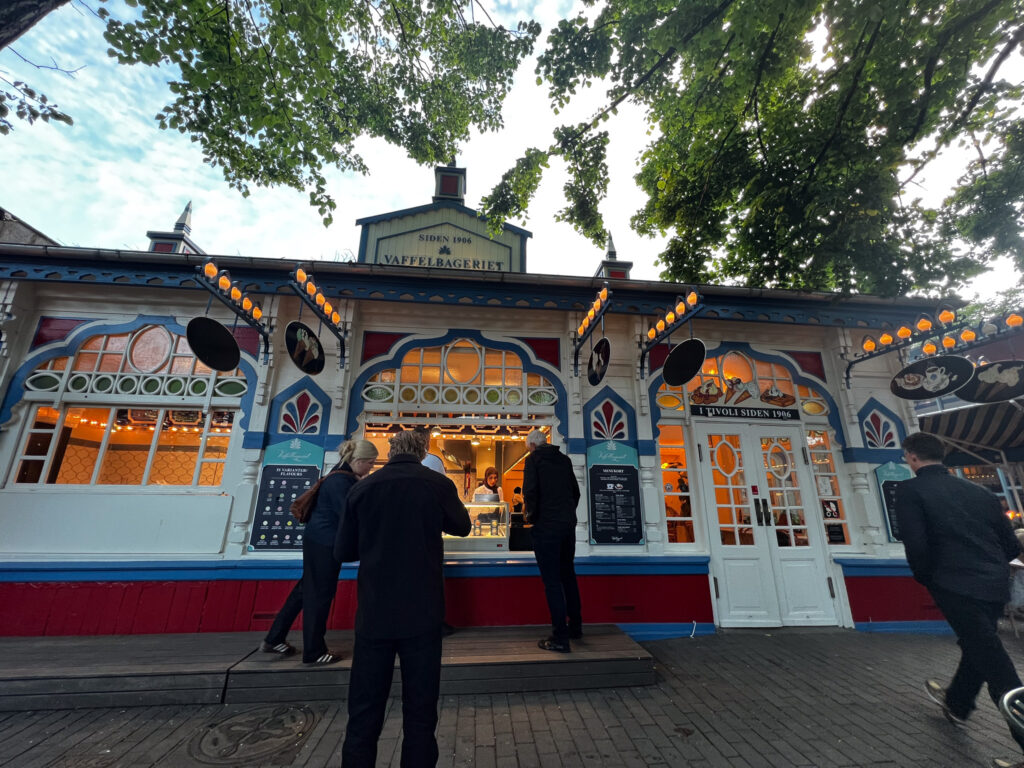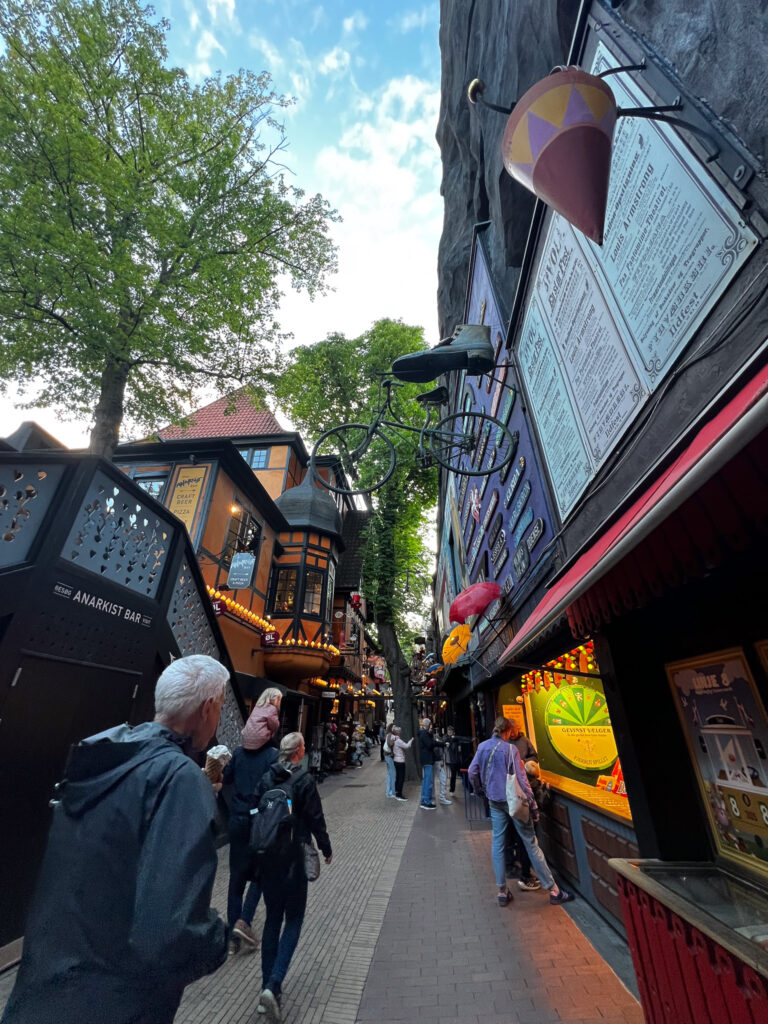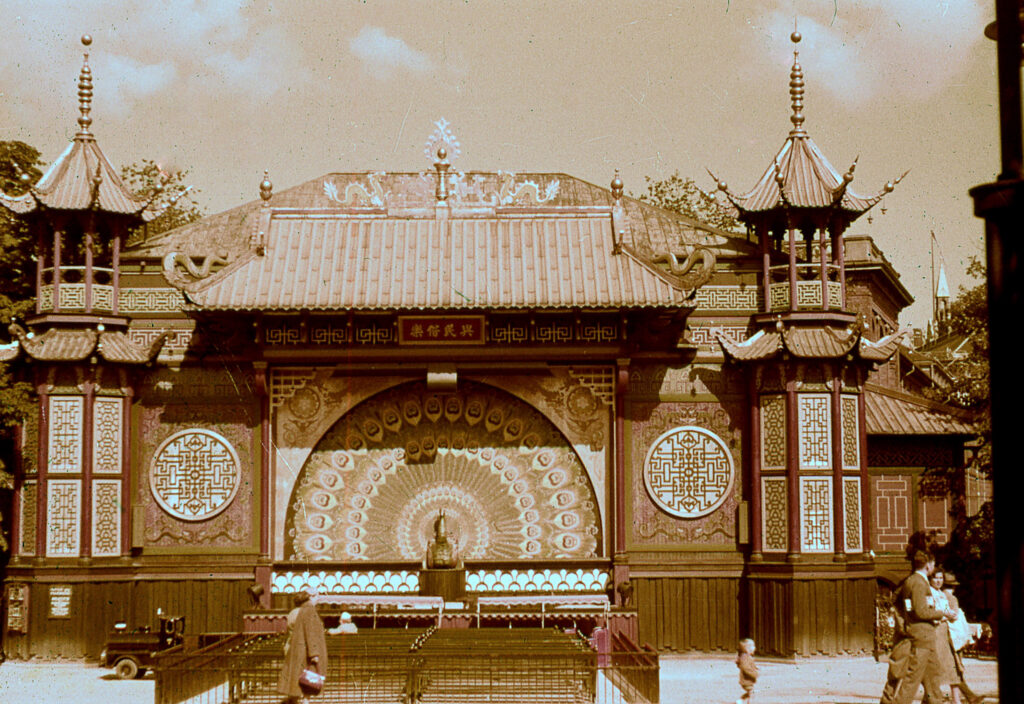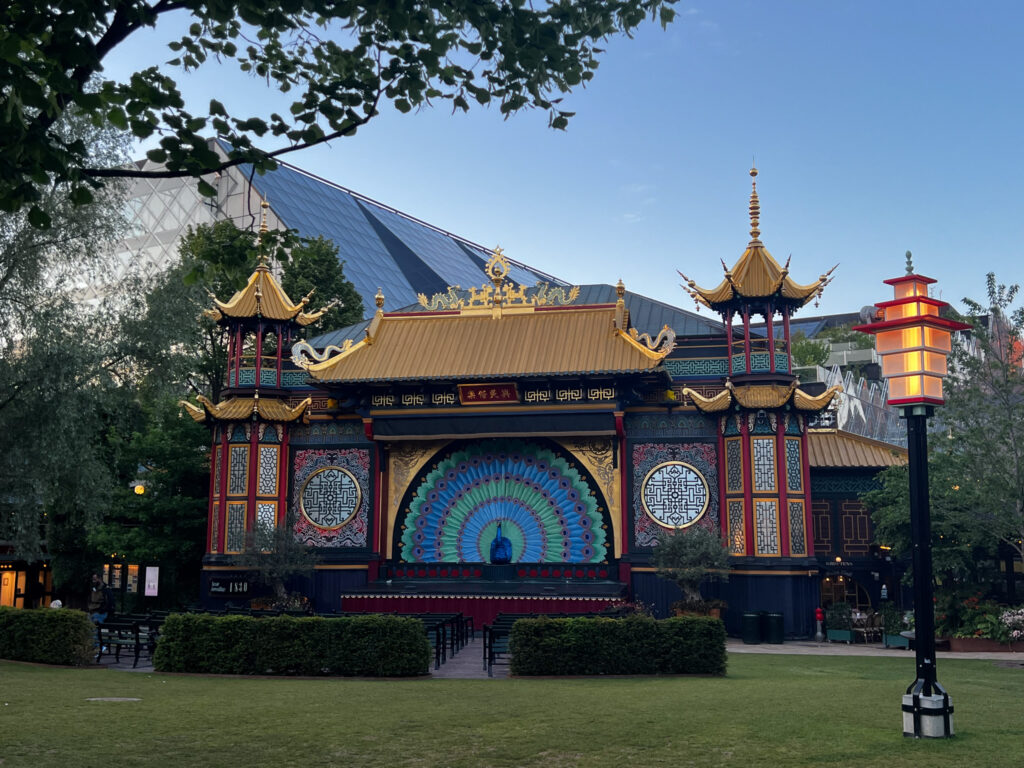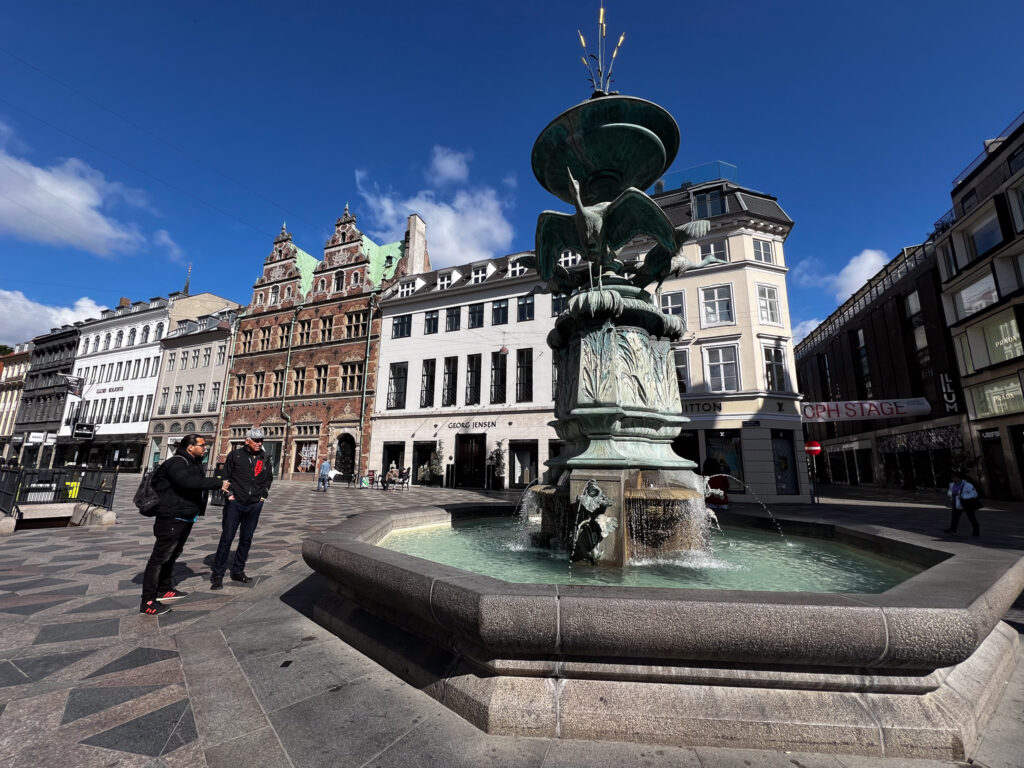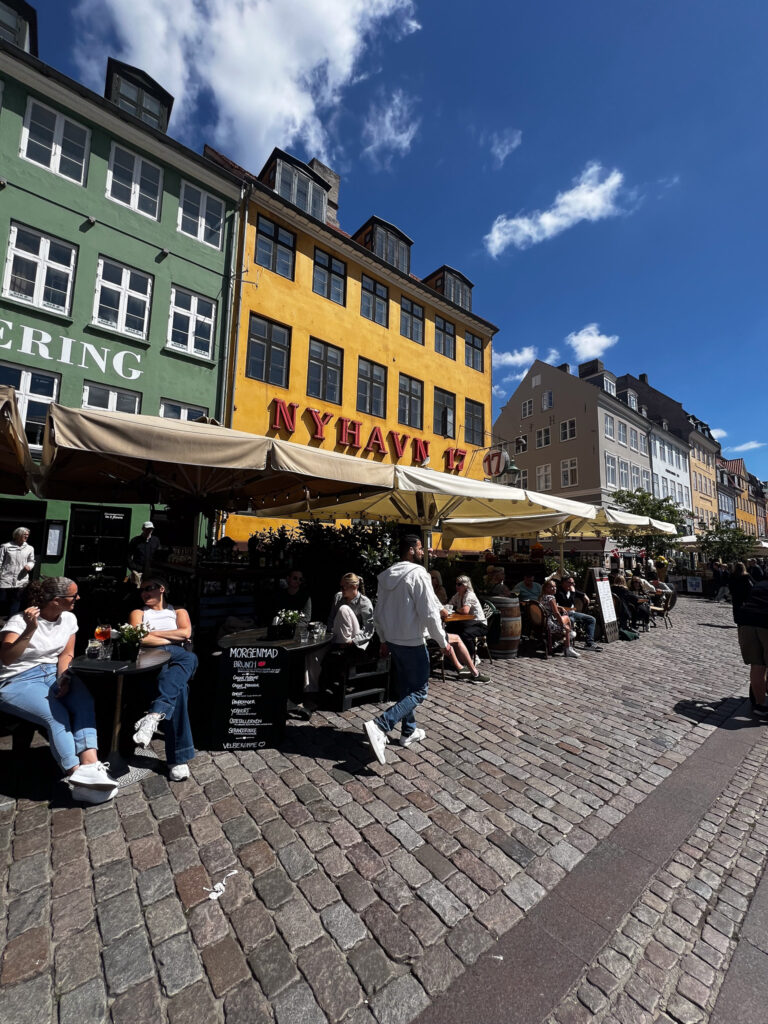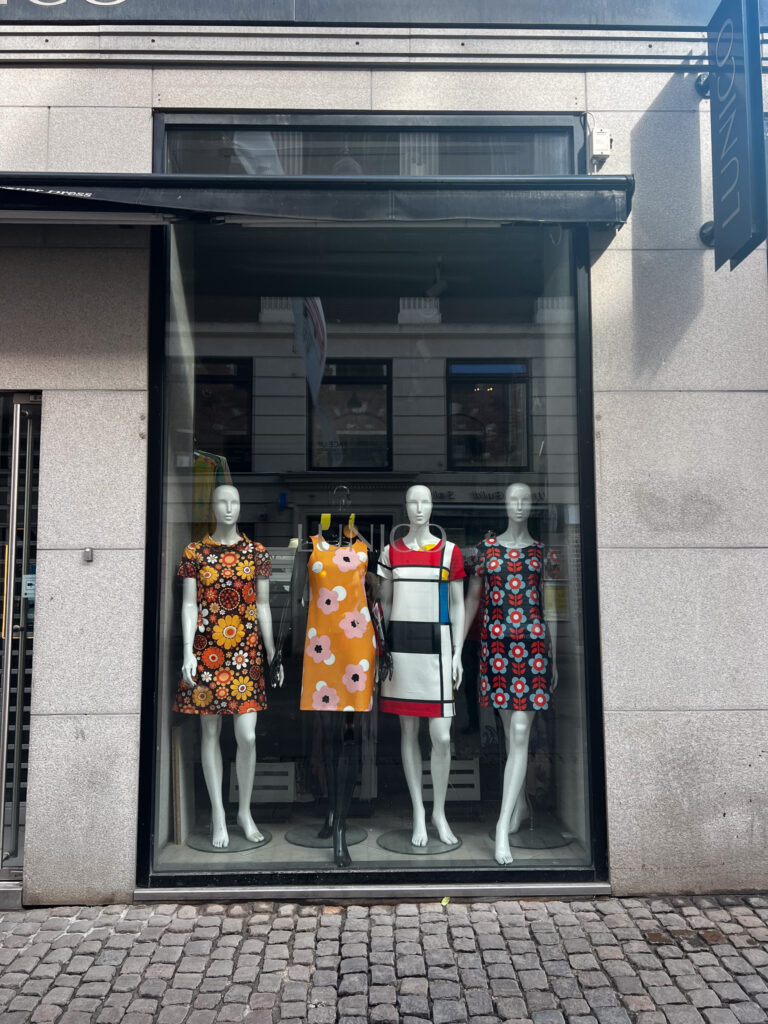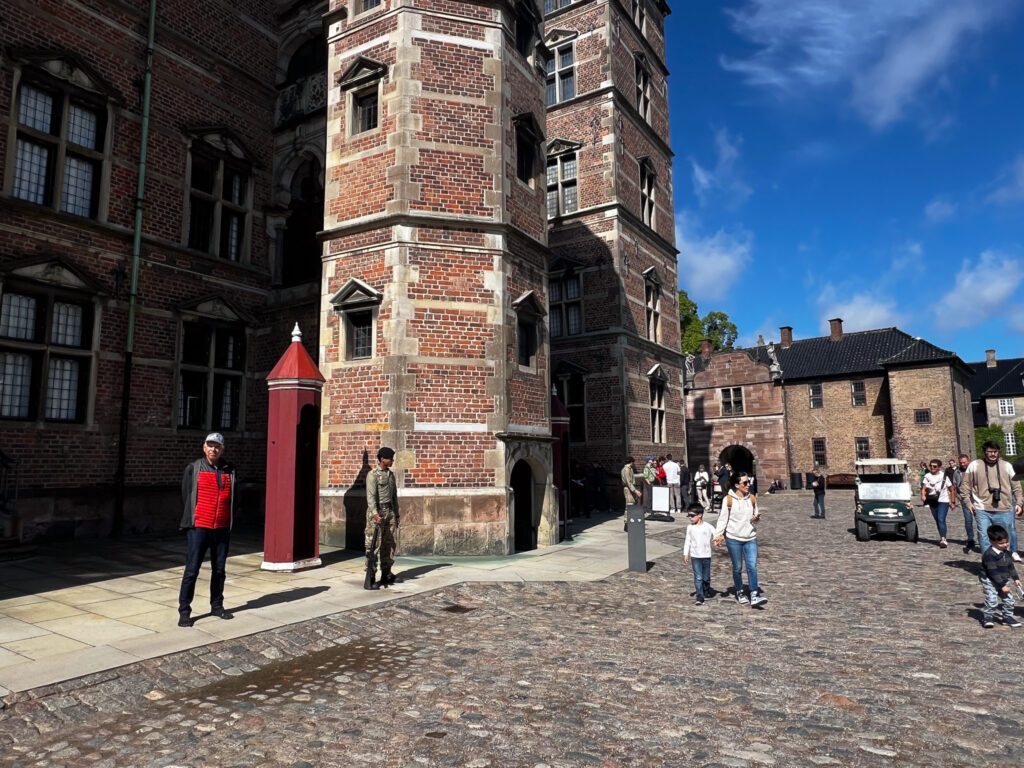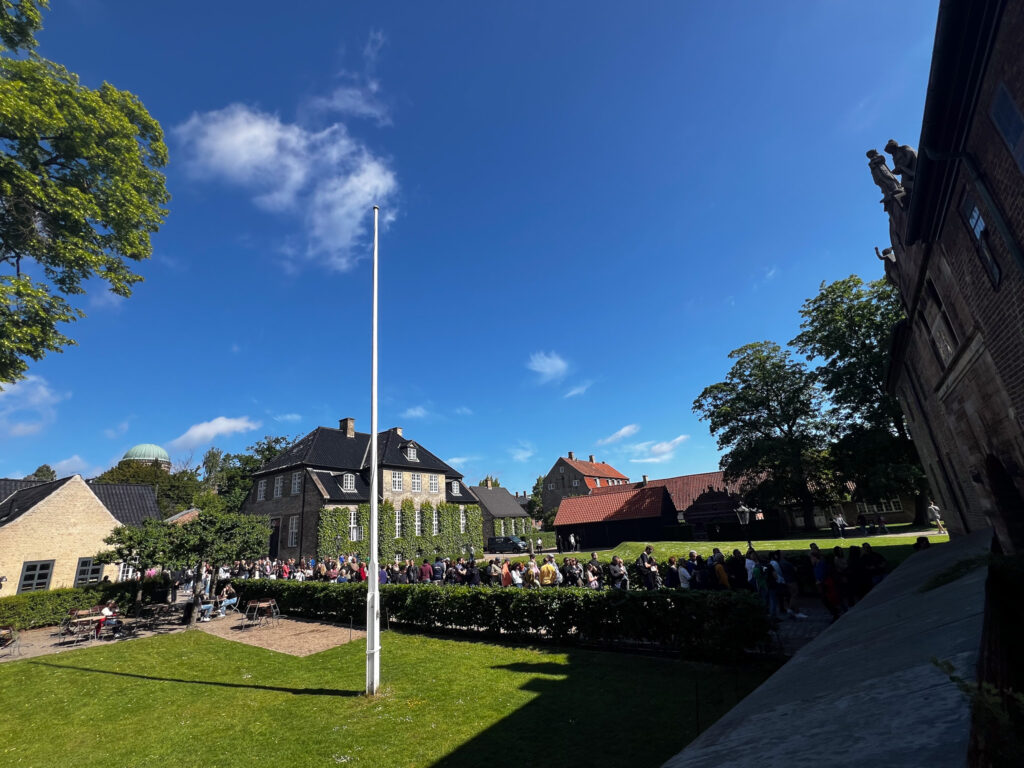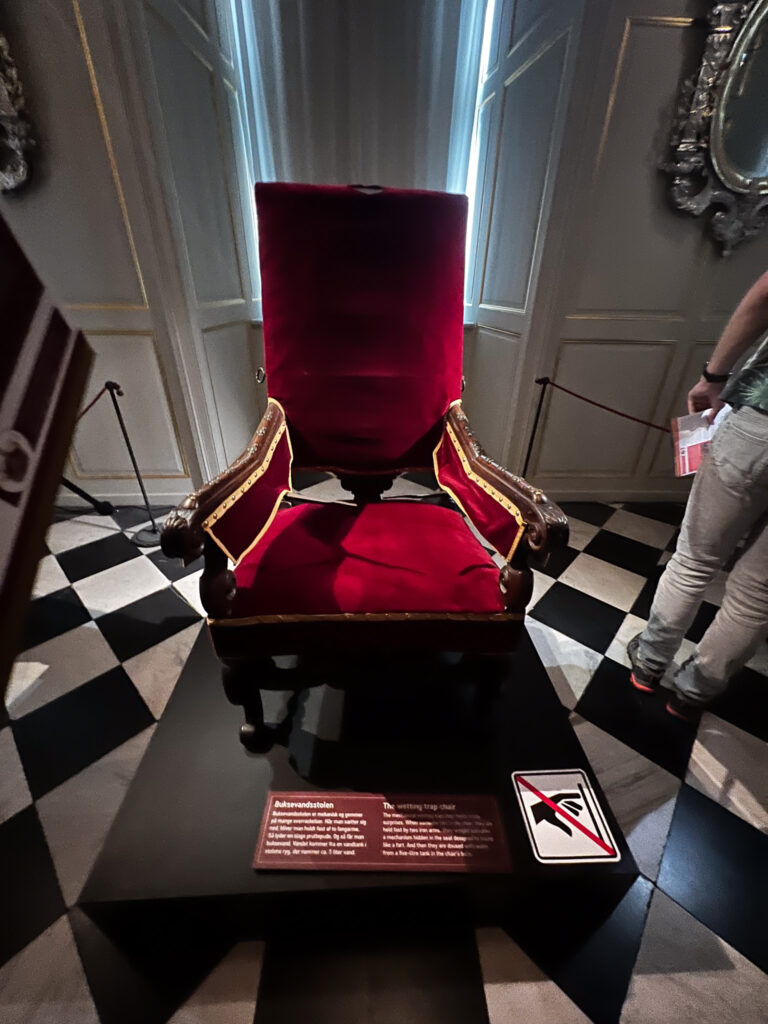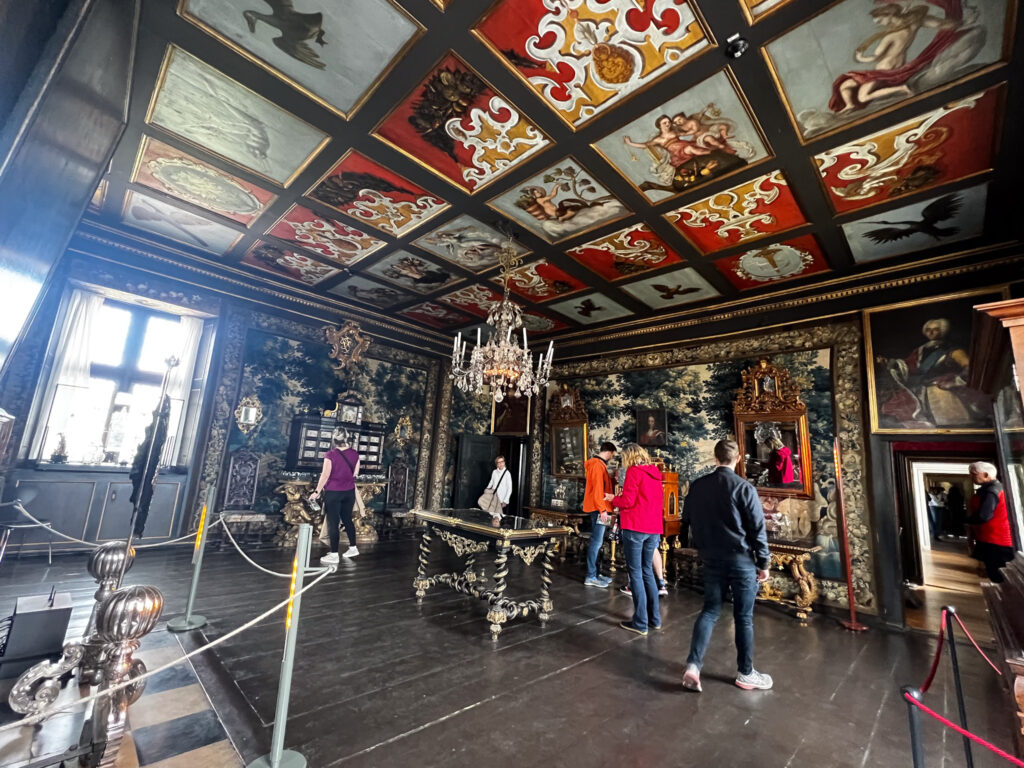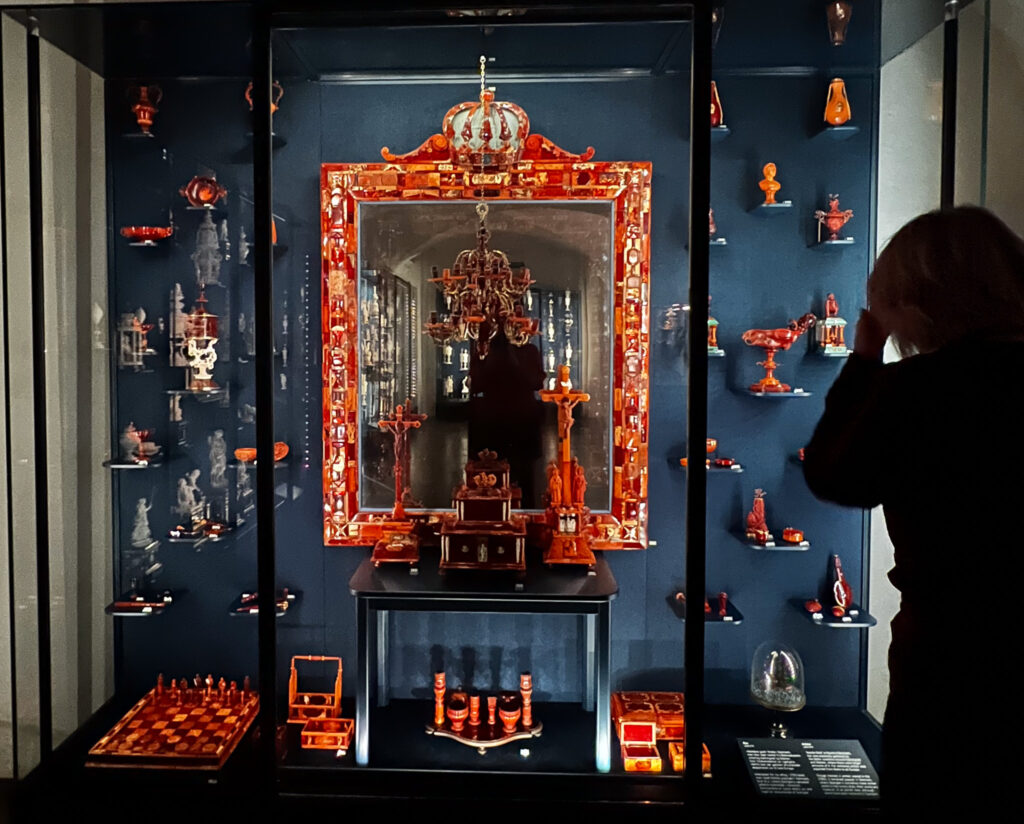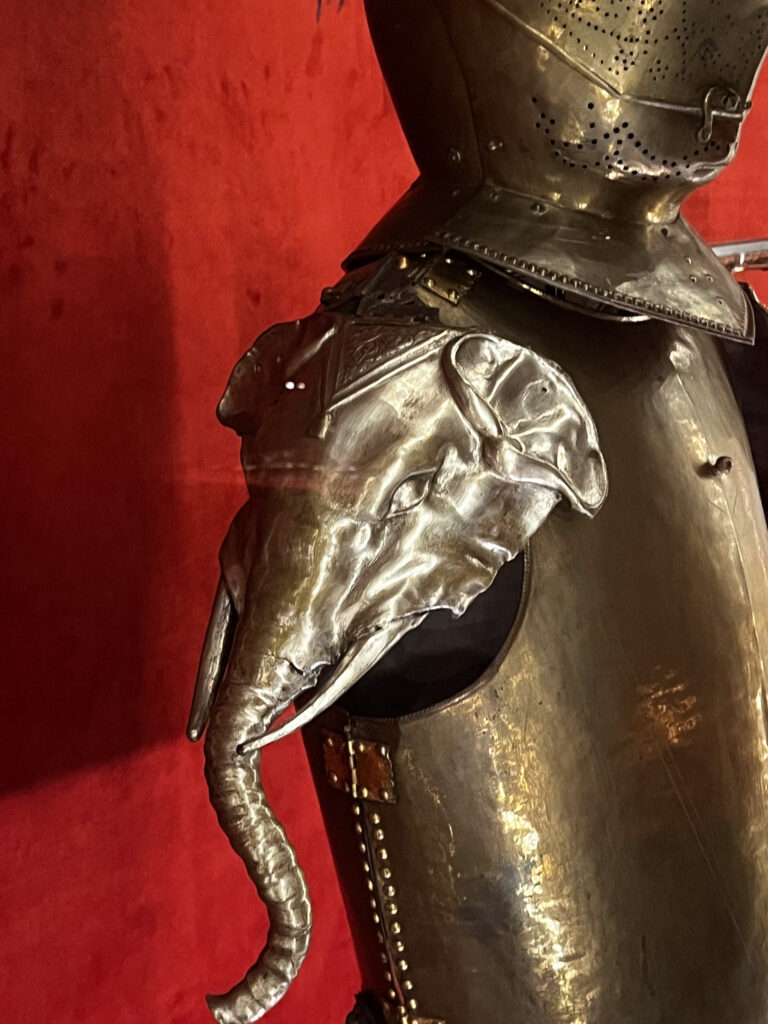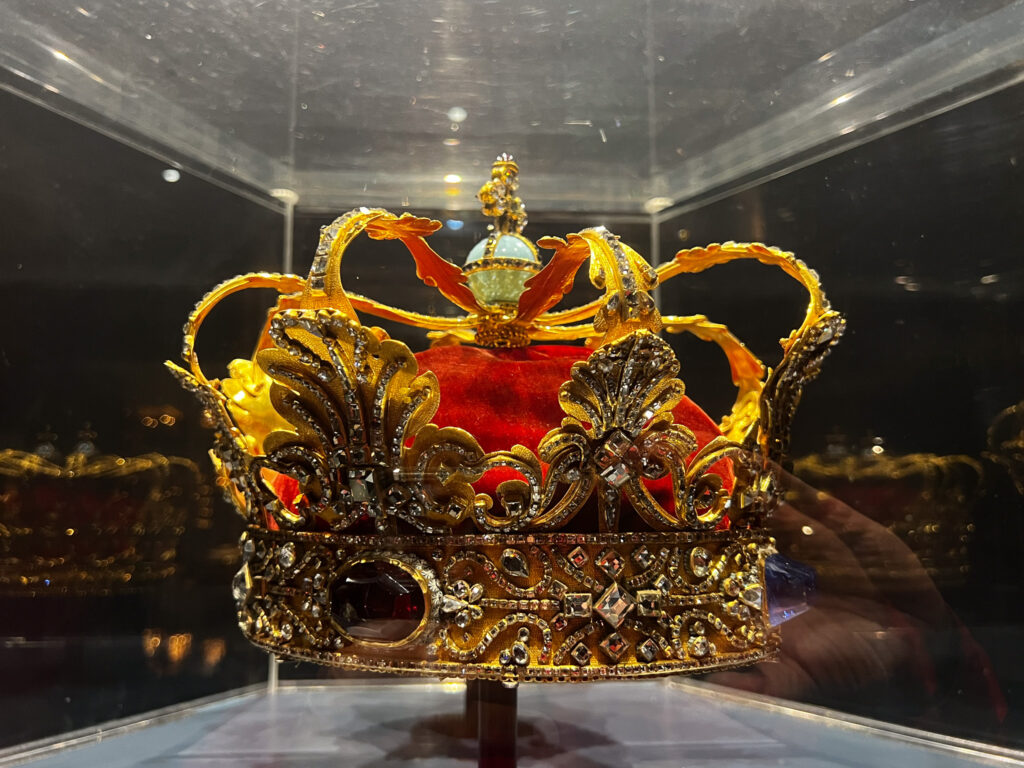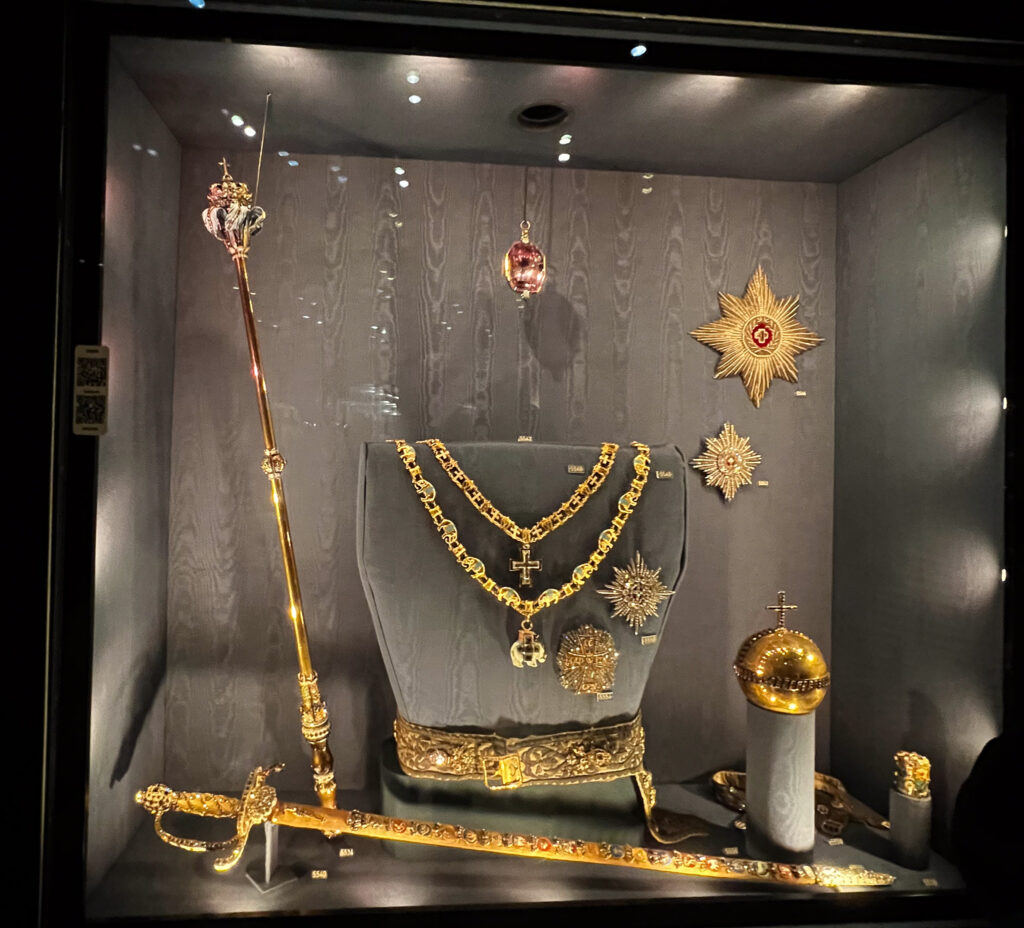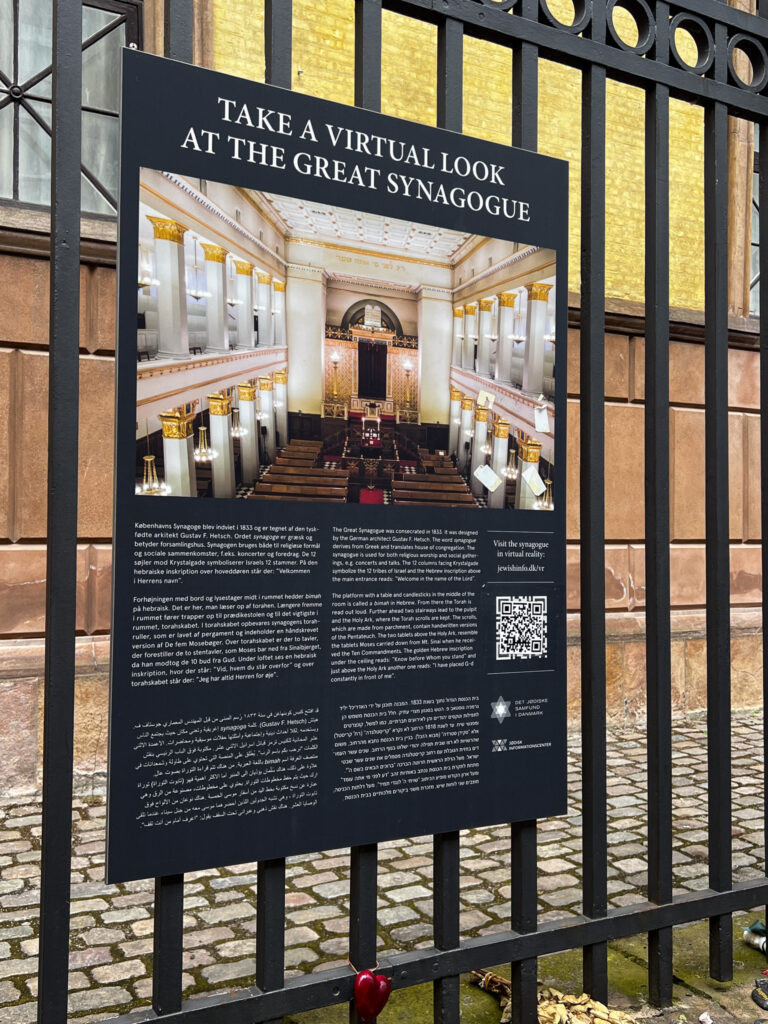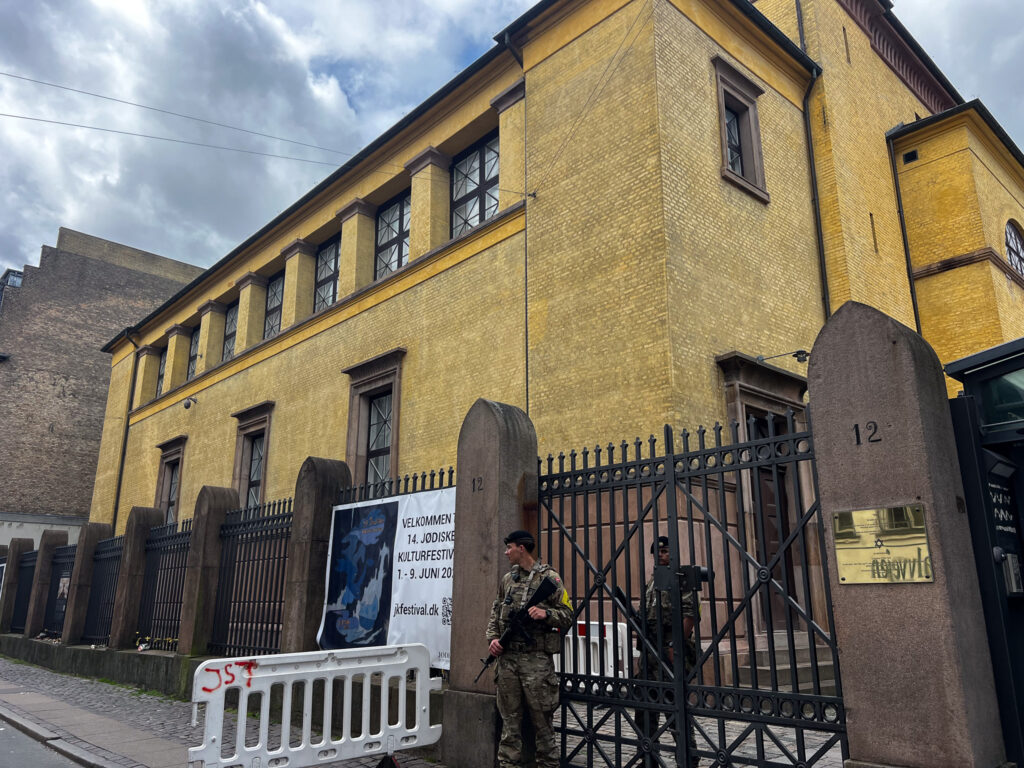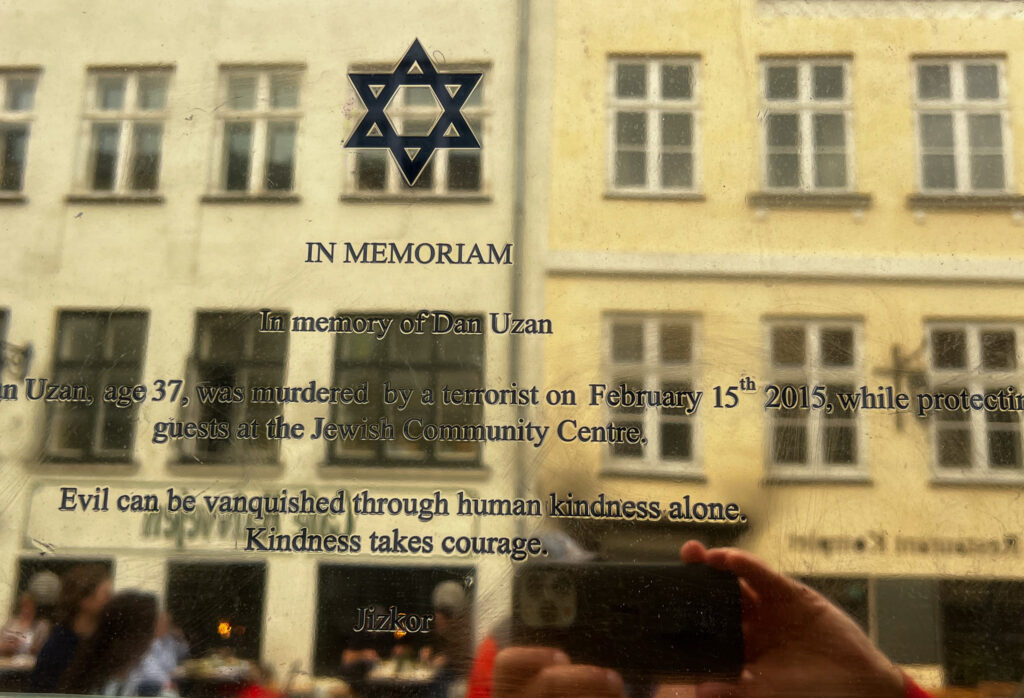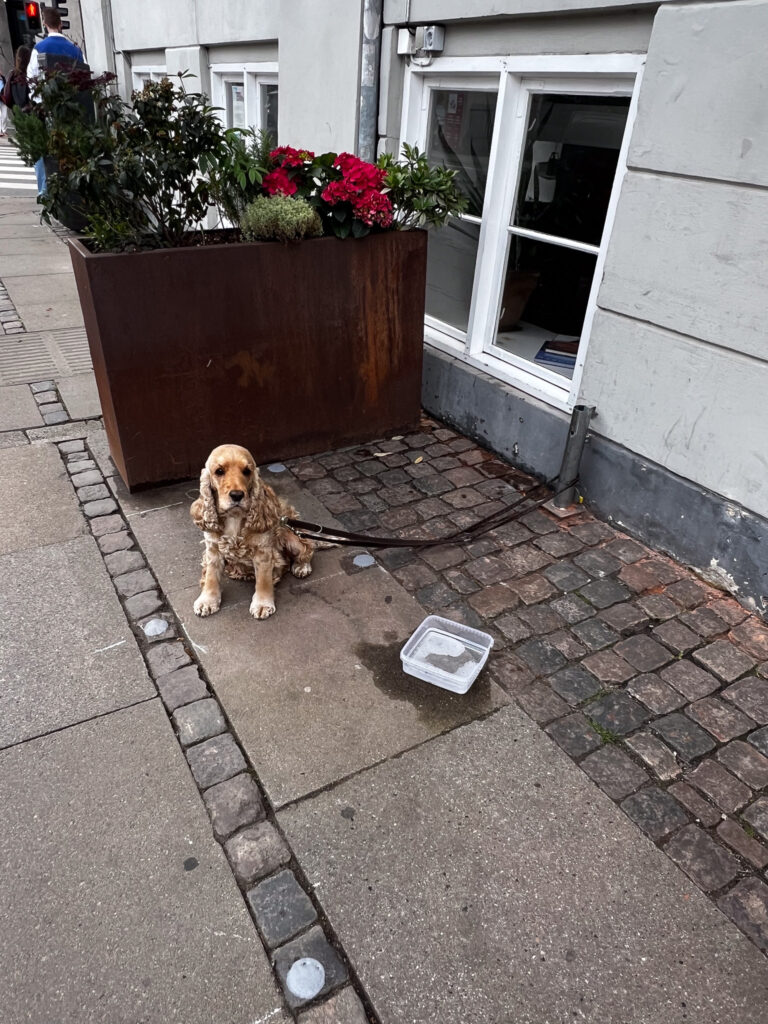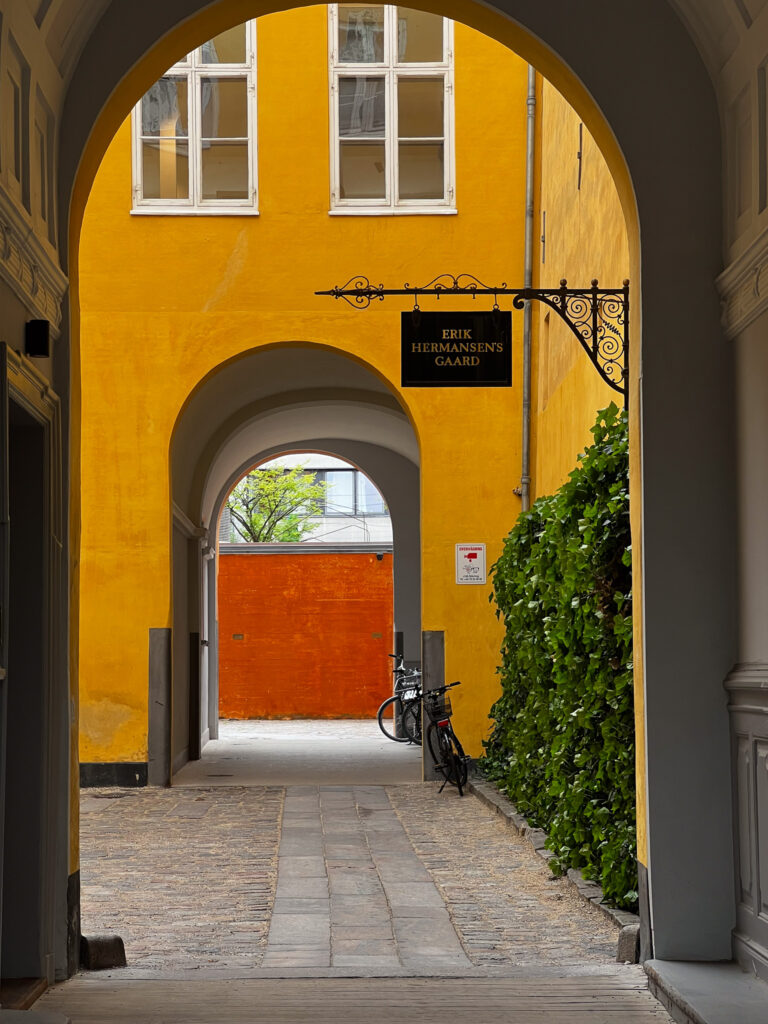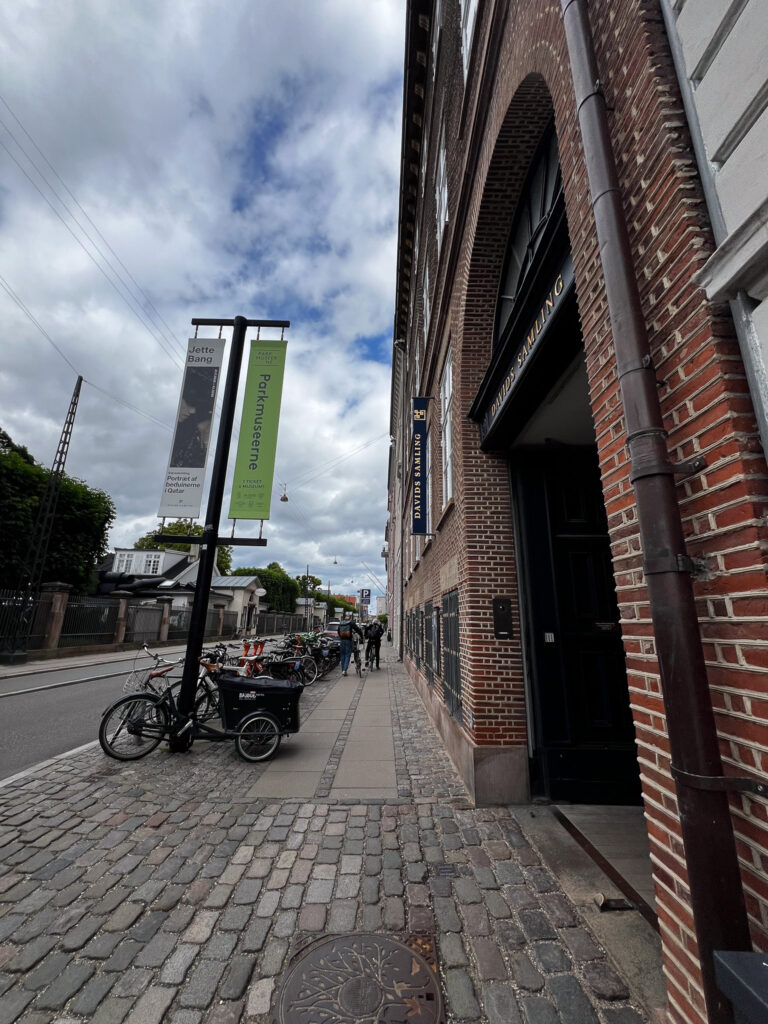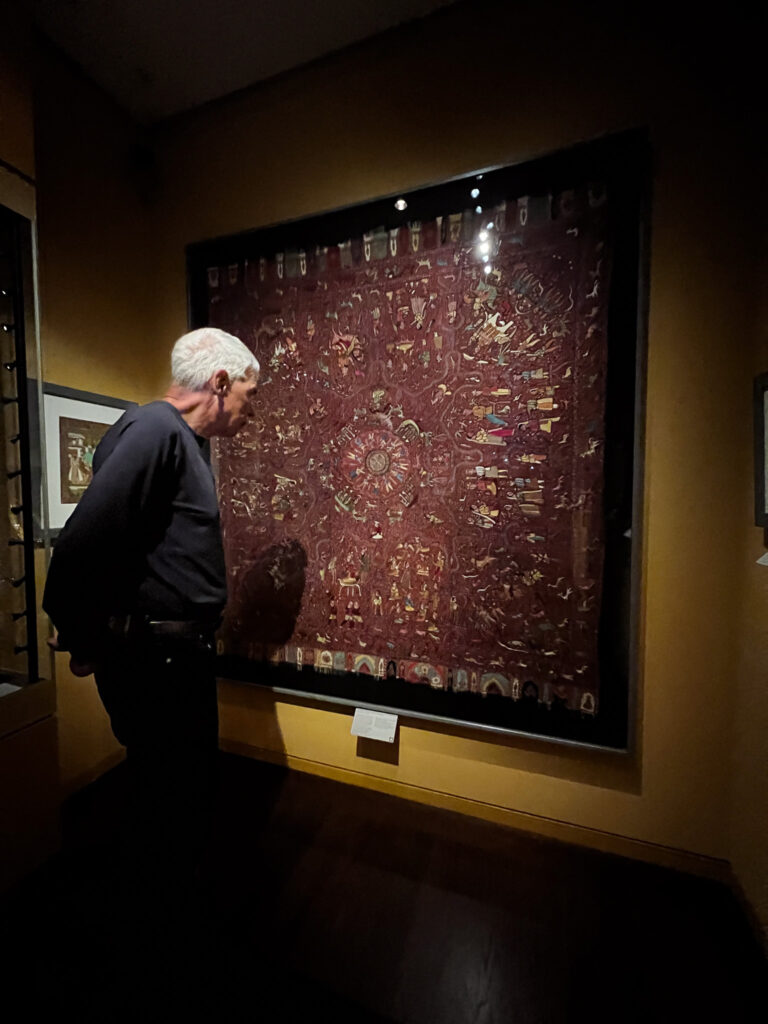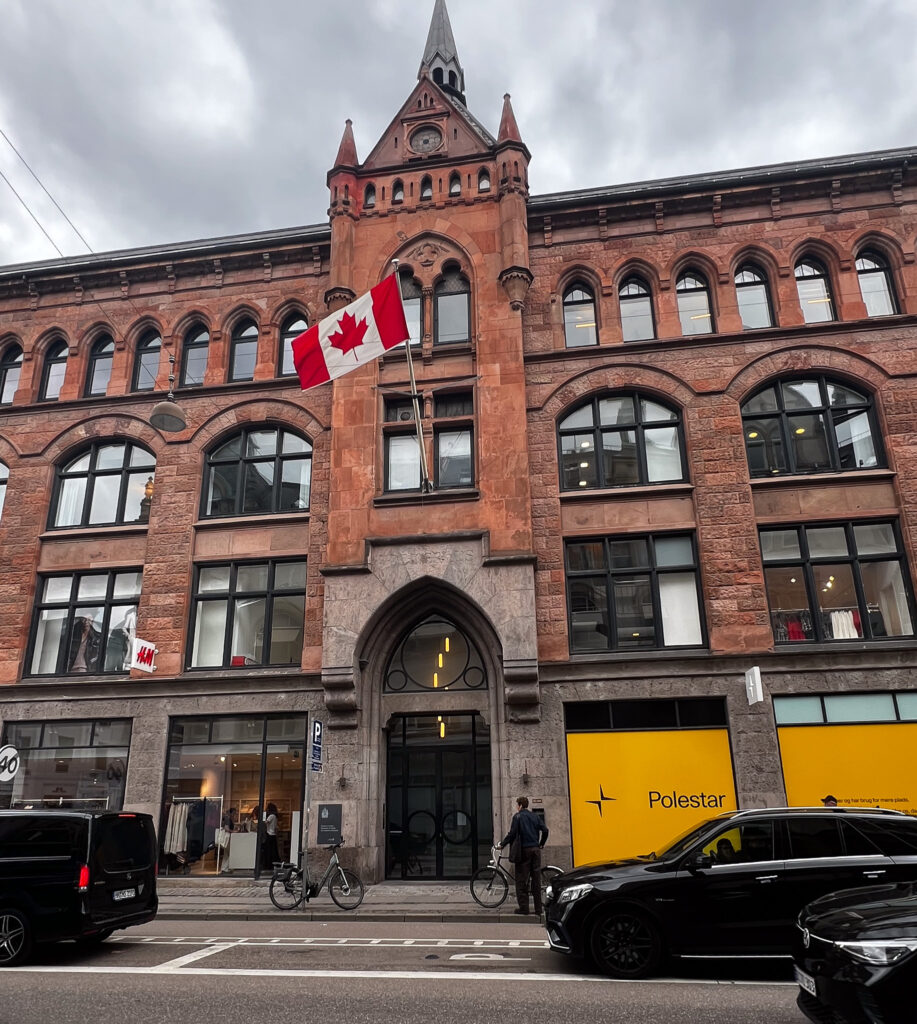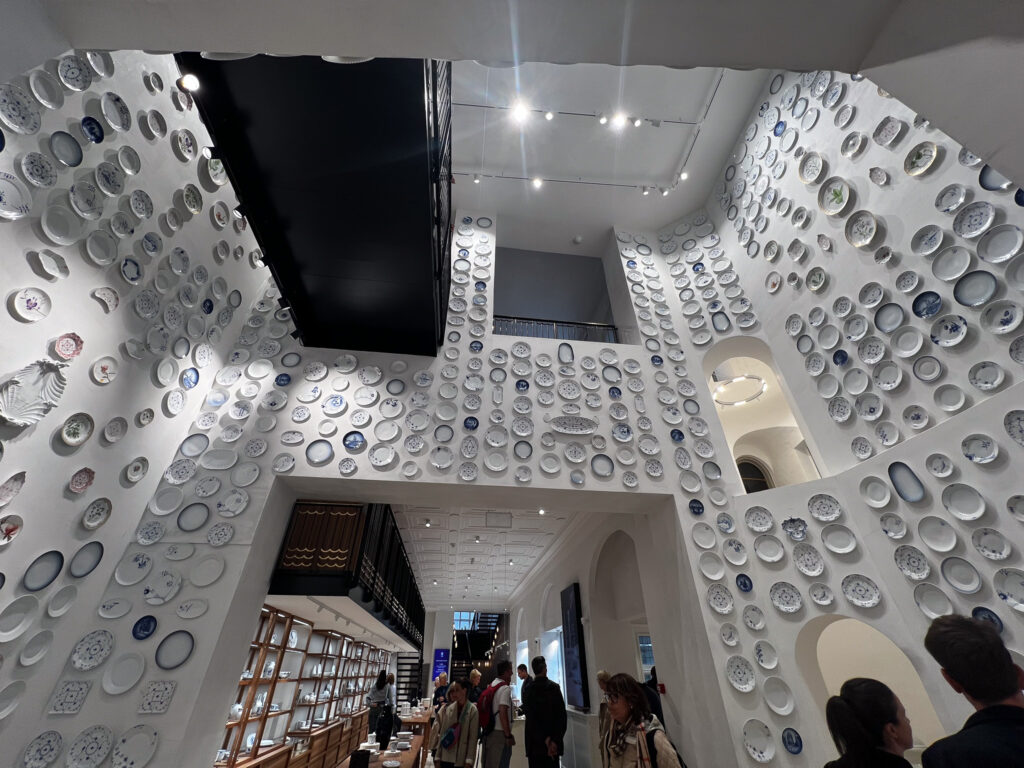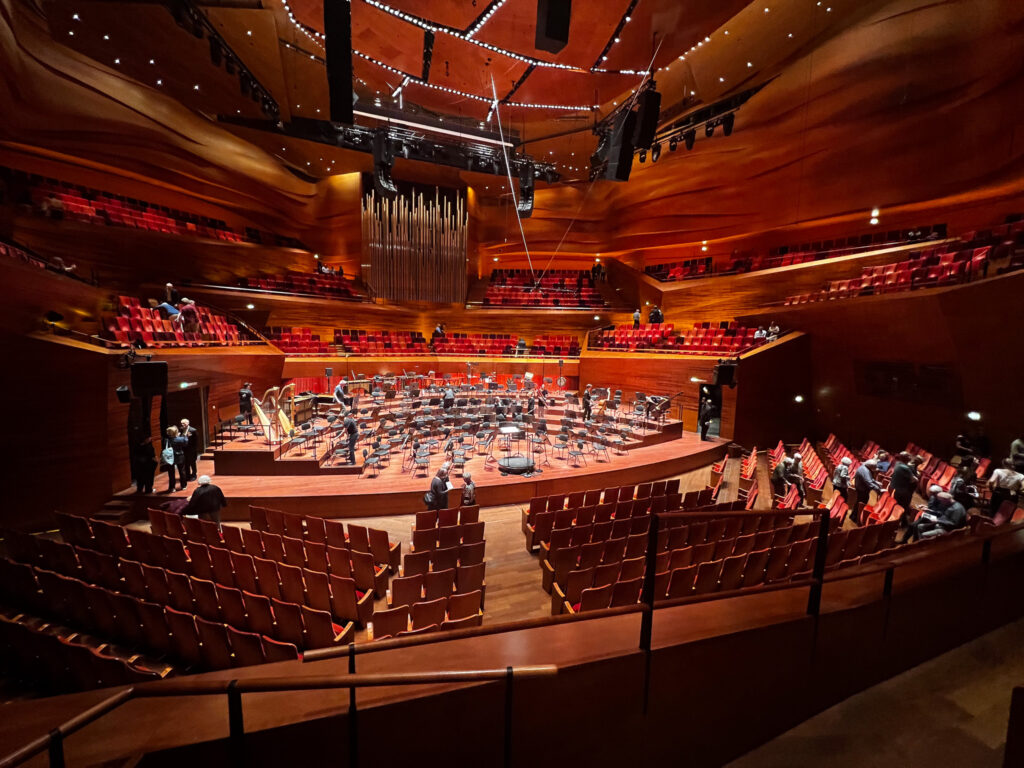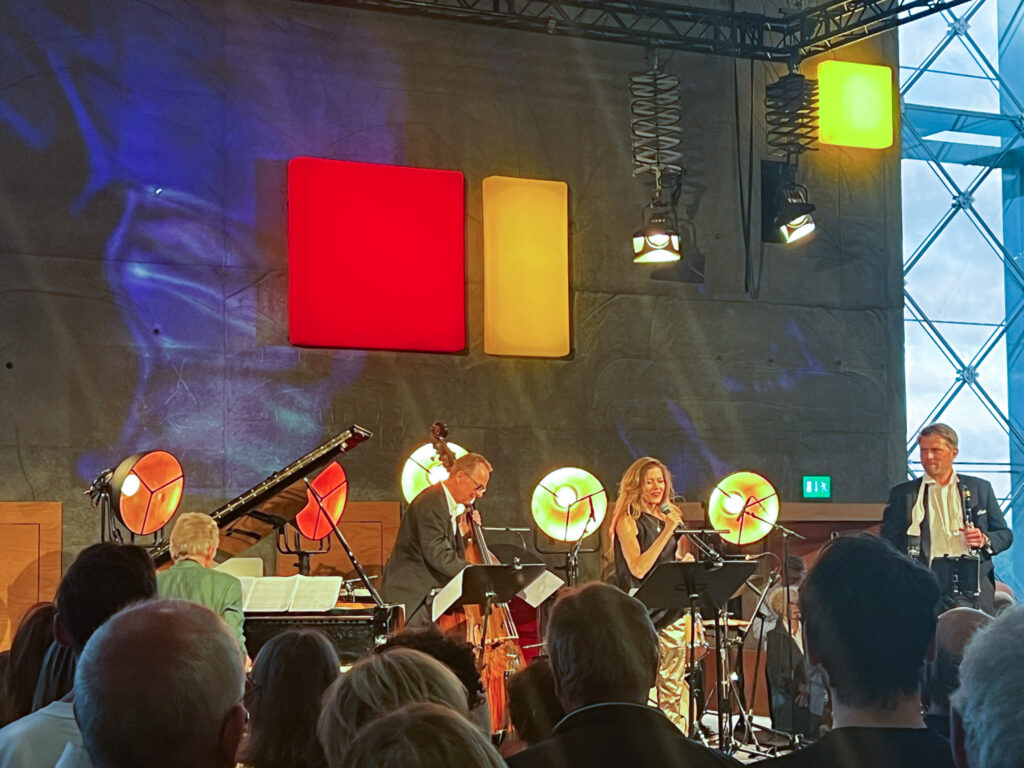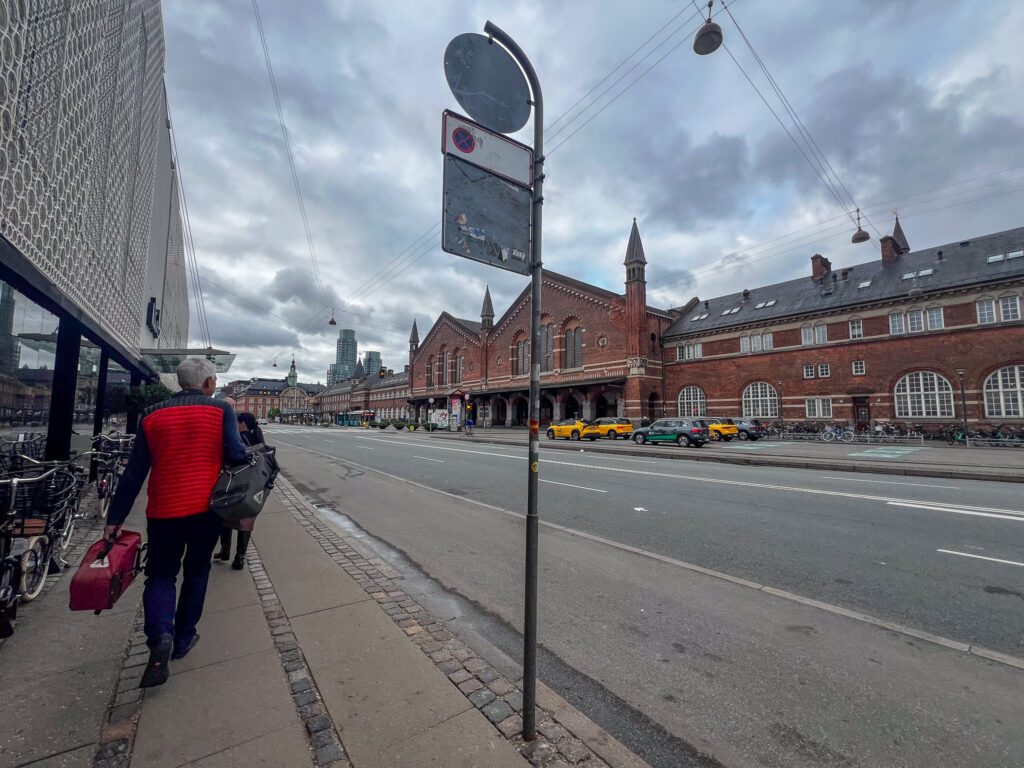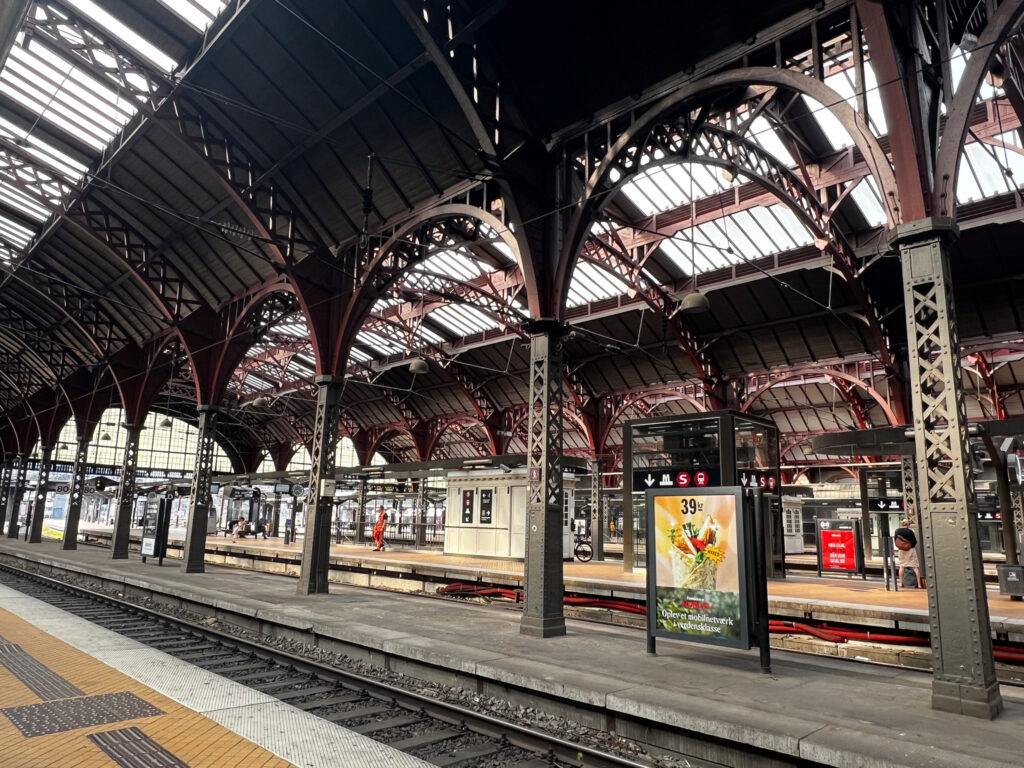Wednesday morning we (and our panniers) jumped onto a train in Hamburg’s beautiful train station to travel to Copenhagen. (Copenhagen also has a beautiful train station; see the photos, below. And note the bikes on the platform in Hamburg, ready to board. So civilized.)
Our route was going to be watery and definitely not a direct line between these two cities. Lots of bridges. Lots of tunnels. Lots of at-sea-level travel.

We arrived around 2:00 and walked the short distance to The Square Hotel where John had stayed in 2019 when he was on his epic Trains and Miniature Railroads trip with Ben Pon. It’s in an excellent location right across from the city hall square – “Rådhuspladsen” – which I found in one of my dad’s photos from 1957 (so of course we replicated the photo.)


We dumped our bags and hit the town to get the lay of the land: our destination was the iconic statue by Edvard Eriksen of The Little Mermaid. It is the symbol of Copenhagen, and it has been on my bucket list since I first saw a photo of it in my early childhood. (If you’re interested, click this link to read more: she’s not just your ordinary statue.) As you can see, our mermaid is very popular and she was well worth the 7 km round trip walk to see her.
Photo of The Little Mermaid by Jack Paddle, 1957
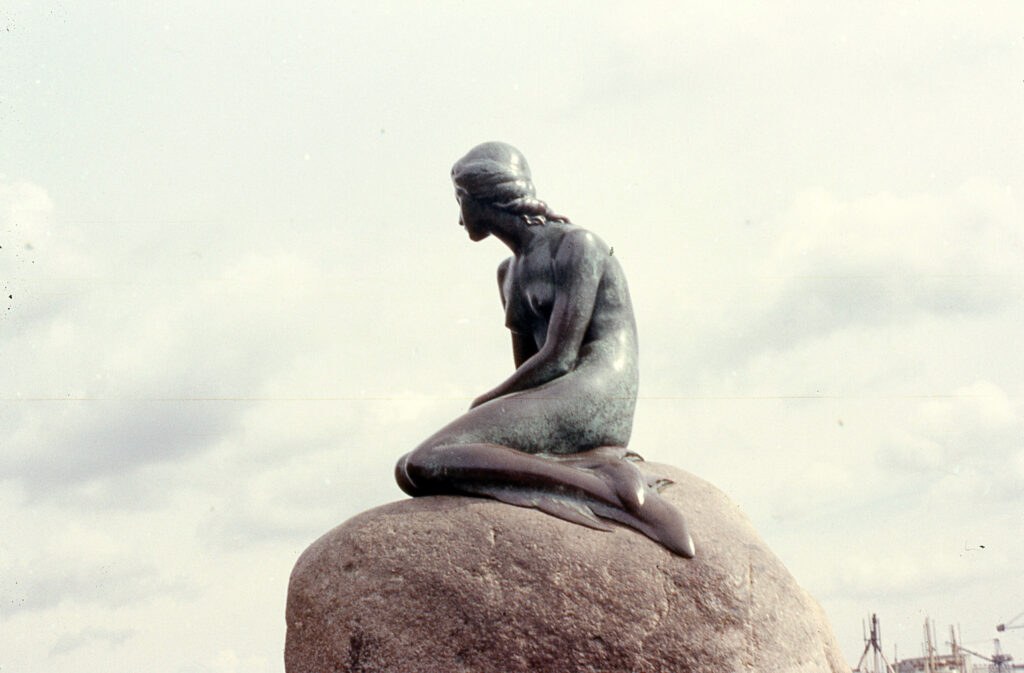
Photos of The Little Mermaid, John Loach, 2025. (He offered to take their photo.)
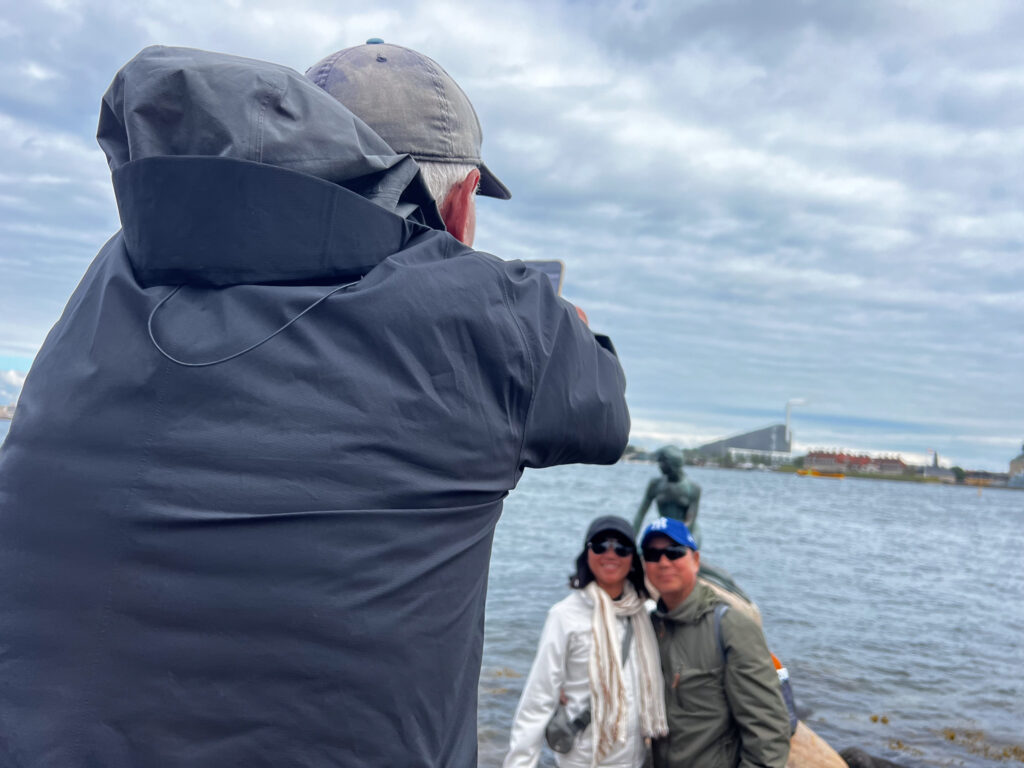

On the way, we passed another Danish icon: a Georg Jensen store. Georg Jensen is famous for its silverware and silver jewelry. My mum owned a Jensen ring, the “Nanna Ditzel”; I can still see it on her elegant hand. So of course, we went into the store. Looking is free…
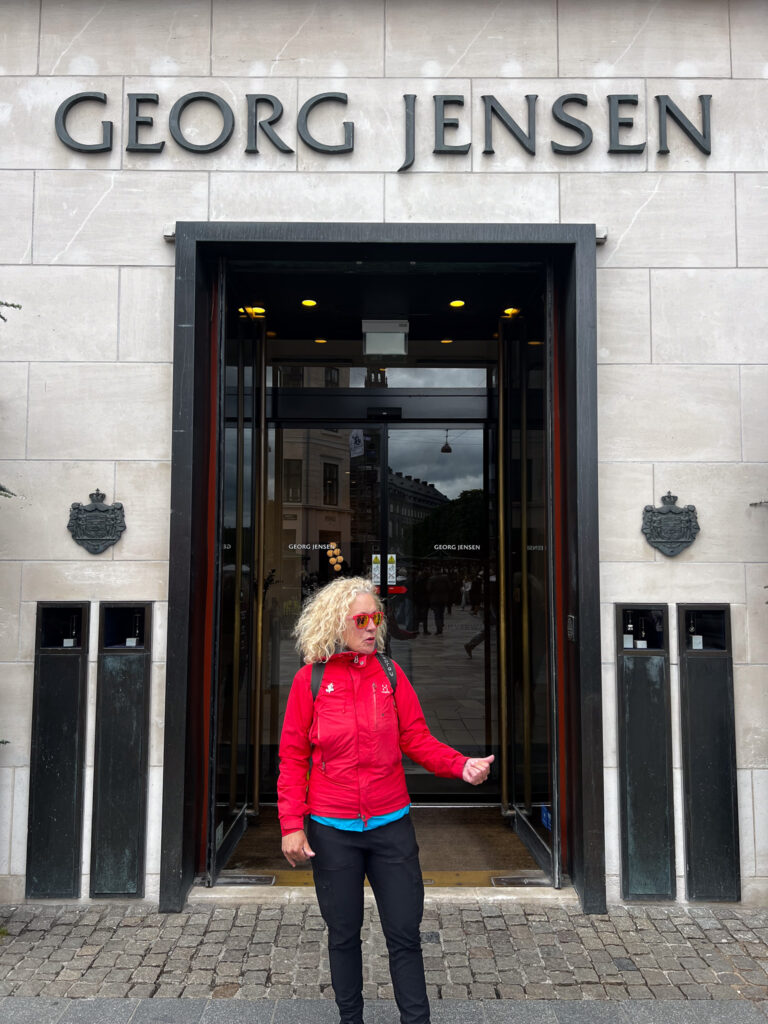
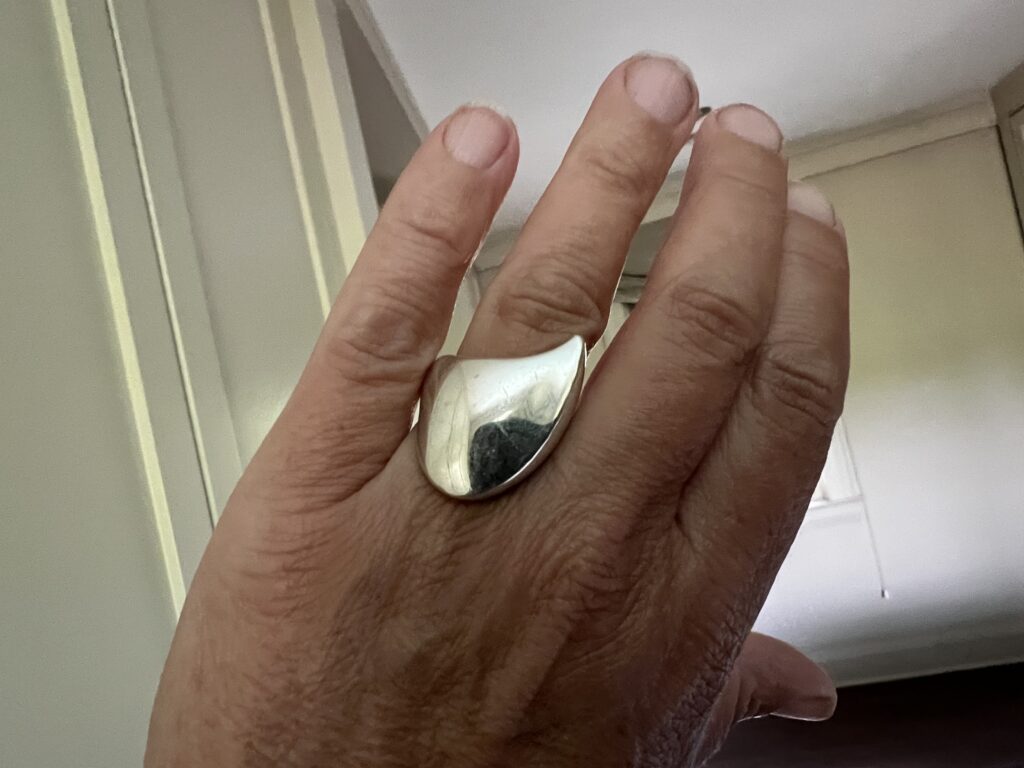
The hand shown here is mine and I’ve been gardening non-stop since we got back so please pardon the dirty fingernails. Tsk.
We enjoyed our walk, it was mostly on pedestrian-only streets and the absence of car and truck noise is a joy. Why don’t we have these in Toronto?
I recognized another building from my parents’ photos (they must have liked Copenhagen a lot, they had many, many photos of this beautiful city). This is the Royal Danish Theatre in 1957, and now.

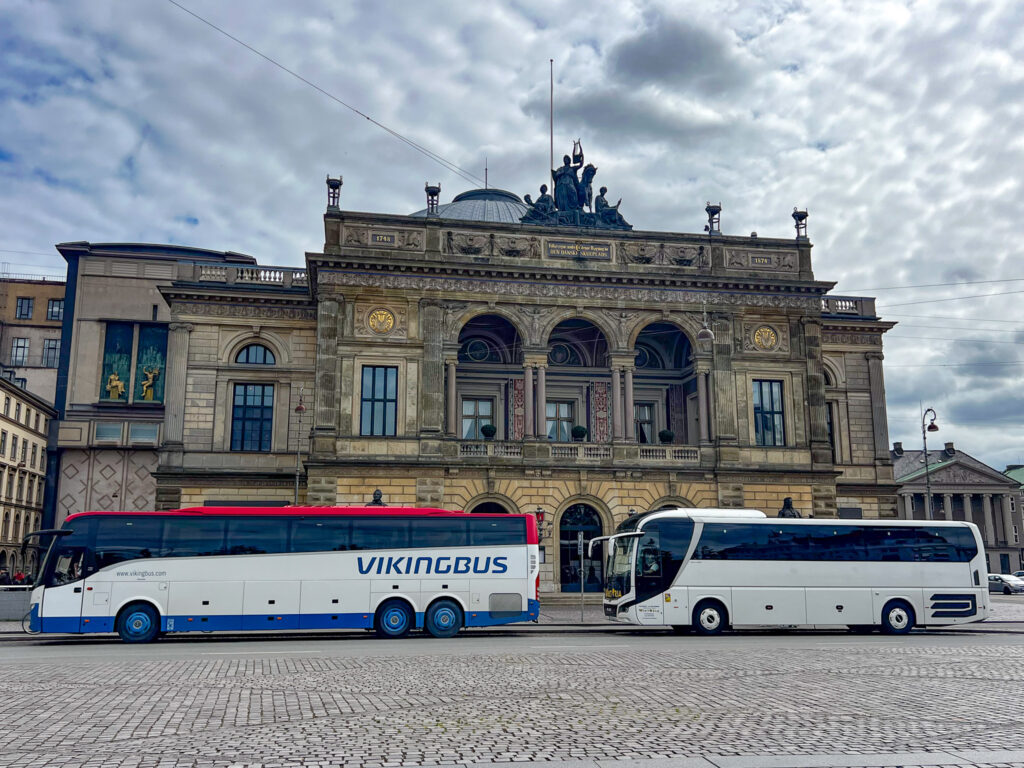
TBH, the walk may or may not have been fuelled by ice-cream. Proof in the photos. And here, as everywhere we travelled, people like dogs.
Still strolling, we passed another Danish icon, the flagship store for Royal Copenhagen China, so we popped in there to take some photos for our dear friend Molly who has a serious collection of their famous, blue plates. The porcelain is instantly recognizable. The company is celebrating its 250th anniversary this year. See photos.
By the way, Copenhagen has an active royal family. (Factoid: they are known as the ‘inlaws’ of Europe because over the years so many of them have married the monarchs of other European countries!) 57-year-old Frederik André Henrik Christian, His Majesty The King, Count of Monpezat, King of Denmark was coronated by his 85 year old mother, Queen Margrethe II in January 2024. Amalienborg – which we were to see on Thursday – is the Royal Family’s winter residence in Copenhagen.
We had worked up an appetite after all of that walking and were excited about our plans for the evening: before we had left Canada I had watched a show about Anthony Bourdain’s visit to Copenhagen and based on what I saw and then read, made a reservation at one of the recommended spots, Restaurant Grøften. Interestingly, it was in Tivoli Gardens which we hadn’t planned on visiting (thinking it would be just too kitschy, and it’s $35 p.p.), but, once we arrived in the park we were enchanted.
Tivoli opened in 1843 and is the third-oldest operating amusement park in the world. In 1943, Nazi sympathisers burnt many of Tivoli’s buildings, including the concert hall, to the ground. Temporary buildings were constructed in their place and the park was back in operation after a few weeks. We walked into a beautiful space with live, open air performances of ballet (waltzes), gorgeous gardens in full bloom, a Chinese Theatre, the happy screams of people riding the wooden roller coaster, ferris wheels, Merry-Go-Rounds, swing rides, live jazz, peacocks strutting, ponds with rowboats. Tivoli is a real gem. (Evidently my parents thought so too, they took lots of photos.) But…. we were there for Restaurant Grøften’s food. John enjoyed another labskaus – having been hooked on it in Hamburg – and declared that this one was even better. I had wiener schnitzel on a bed of huge white asparagus. Photos, below. We spent the rest of the evening strolling around Tivoli, and went to bed, happy and tired campers.
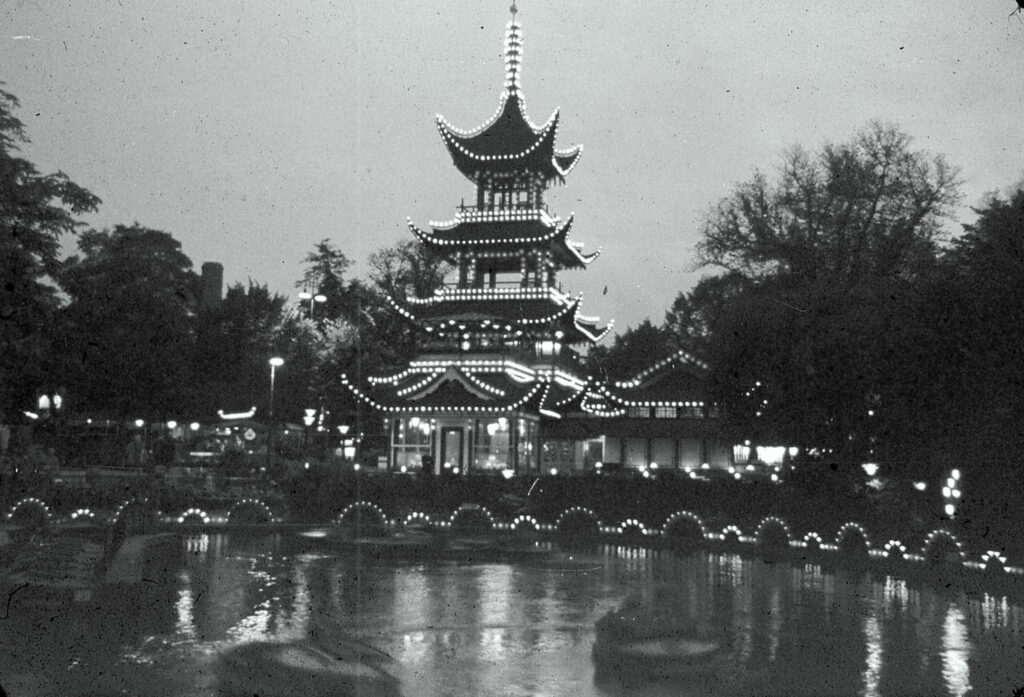
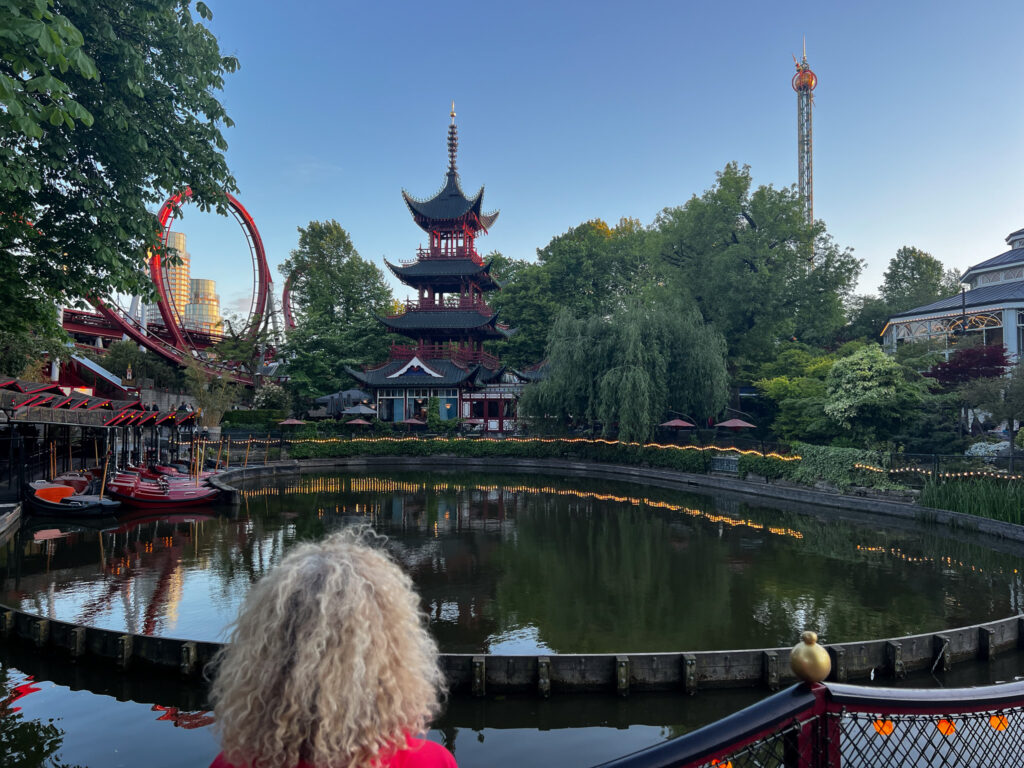
Thursday morning we had booked a private walking tour. Unfortunately, our guide was not as knowledgeable as any of the guides we have ever used in any of our travels, so we had a lacklustre, poky stroll around Copenhagen and in fact had seen many of the sites he took us to – or planned to take us to – already. That would have been alright except he didn’t know anything about them! No history, no context, just a look and point. Tsk. No worries. We said goodbye, and then commenced our usual brisk walking pace through the streets, on our own.
Travellers’ note: I was impressed with the number of beautiful statues there are in Copenhagen, for example this one of Hans Christian Andersen (who looks eerily like Sir John A. Macdonald). “Although a prolific writer of plays, travelogues, novels, and poems, Andersen is best remembered for his literary fairy tales. Consisting of 156 stories across nine volumes, they have been translated into more than 125 languages. They have become embedded in Western collective consciousness, accessible to children as well as presenting lessons of virtue and resilience in the face of adversity for mature readers.
His most famous fairy tales include “The Emperor’s New Clothes“, “The Little Mermaid“, “The Nightingale“, “The Steadfast Tin Soldier“, “The Red Shoes“, “The Princess and the Pea“, “The Snow Queen“, “The Ugly Duckling” (my favorite), “The Little Match Girl“, and “Thumbelina.” Andersen’s stories have inspired ballets, plays, and animated and live-action films”. Wikipedia.

Enjoy this five minute clip from the Danny Kaye version of The Ugly Duckling. It made six year old (and probably overly-sensitive) Patti cry when she first saw it on the black and white TV in Scarborough.
Unbeknownst to us, it was Ascension Day, a public holiday, and while most stores were closed, the streets were full of people enjoying sunshine. Packs of Danish boyscouts and girlscouts were running through the streets on various scavenger hunts.
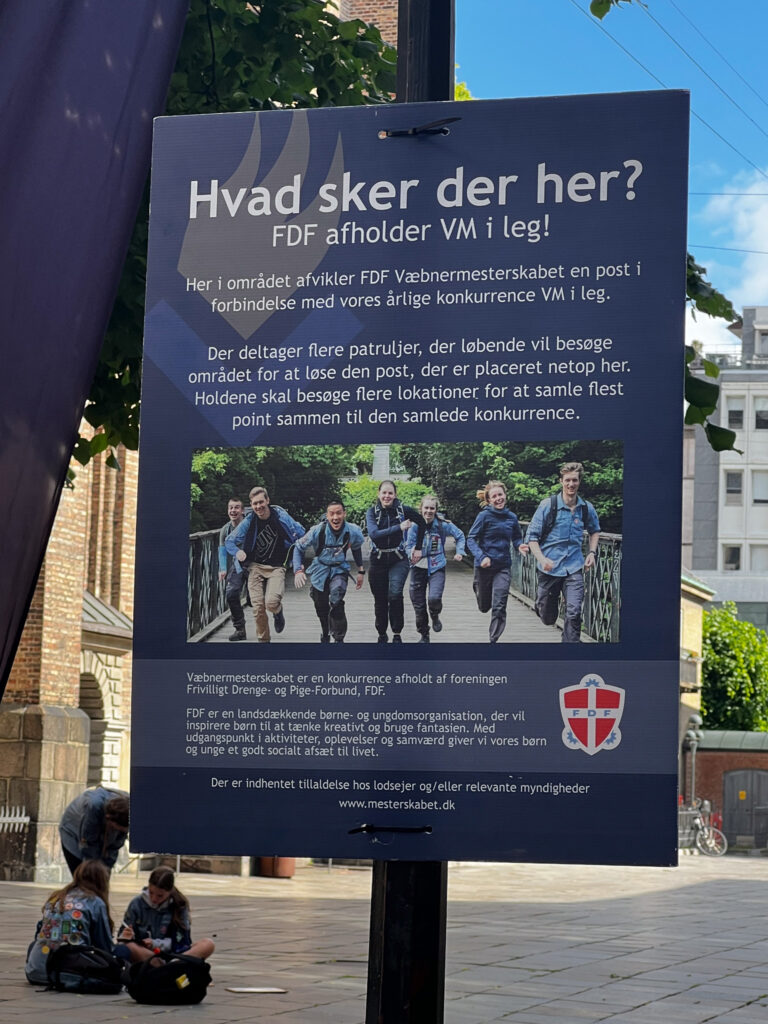
We walked and walked and walked and walked. Meanwhile, others were cycling. It appears that cycling is as popular in Denmark as it is in Holland, judging from the size and popularity of the bicycle parking area outside the subway station.

Our next destination was Rosenborg Castle where, luckily, John had made a timed visit reservation, otherwise we would have had a two-hour-wait to get in. Travellers’ tip: if I haven’t said it before, I’ll say it now: reserve, in advance, online, whenever you can.
We watched the changing of the guard (as had my parents, see photos), walked through beautiful rooms with original furniture (including a fart chair) and a loo, and saw the Crown jewels. Observation: Danish royalty have a thing for elephants, amber, and ivory.
Travellers’ tip: Rosenborg Castle is one of the most beautiful castles we have ever seen. HIGHLY RECOMMENDED.
Walking on, we passed Copenhagen’s Great Synagogue, guarded by an armed soldier. (Here’s one reason why.) We read the plaques out front (so sad) (see photos) and later I did a little research about Denmark’s treatment of their Jewish citizens during WWII. It’s an interesting and inspiring story, especially when you read about The Elsinore Sewing Club, a resistance group formed in 1943 during the Nazi occupation of Denmark, to help Jewish refugees escape. They organized the covert transportation of Jewish people across the Øresund Strait to safety. The group was comprised of ordinary Danes who risked their lives and livelihoods to help their Jewish neighbors, using various means of transportation, including fishing boats and speedboats, to ferry refugees to neutral Sweden. The Elsinore Sewing Club, along with other resistance efforts, played a crucial role in saving the lives of thousands of Danish Jews from the Holocaust.
Friday, our last full day of our Spring 2025 trip (!!!) was going to end with a KLANG because while he was doing a little research into Copenhagen’s cultural life, John had discovered that Canadian soprano/conductor/superstar Barbara Hannigan was going to be performing her Gershwin programme with the Danish Radio Symphony Orchestra at the DRO concert hall. John wasn’t familiar with Hannigan’s work, but I sure knew about her, and, in fact, had attended a brilliant masterclass that she presented at the Faculty of Music at UofT, about a decade ago. I’ve never forgotten it. So, on Thursday night, we spent about an hour navigating ticketing sites in Danish in order to get great tickets (so much less expensive than in Toronto!!!!) and a dinner reservation in the concert hall’s restaurant which is (brilliantly) called “KLANG”.
But…. first of all I want to talk about Danish breakfasts. John is a breakfast-buffet cereal-table kind of guy. However, I really really really appreciate a protein-table. Rollmops. (Pickled herring.) Liverwurst. Nutty Danish breads. Pork Roll. Redolent Danish Blue Cheese. A little greasy sausage never hurt anyone. (LOL). The Square Hotel breakfast was a dream come true for me. We needed to fuel up in the mornings because we were averaging between 17,000 – 23,000 steps every day. Those breakfasts were worth every too-expensive Danish kroner. Okay, I’ll stop now. HIGHLY RECOMMENDED.
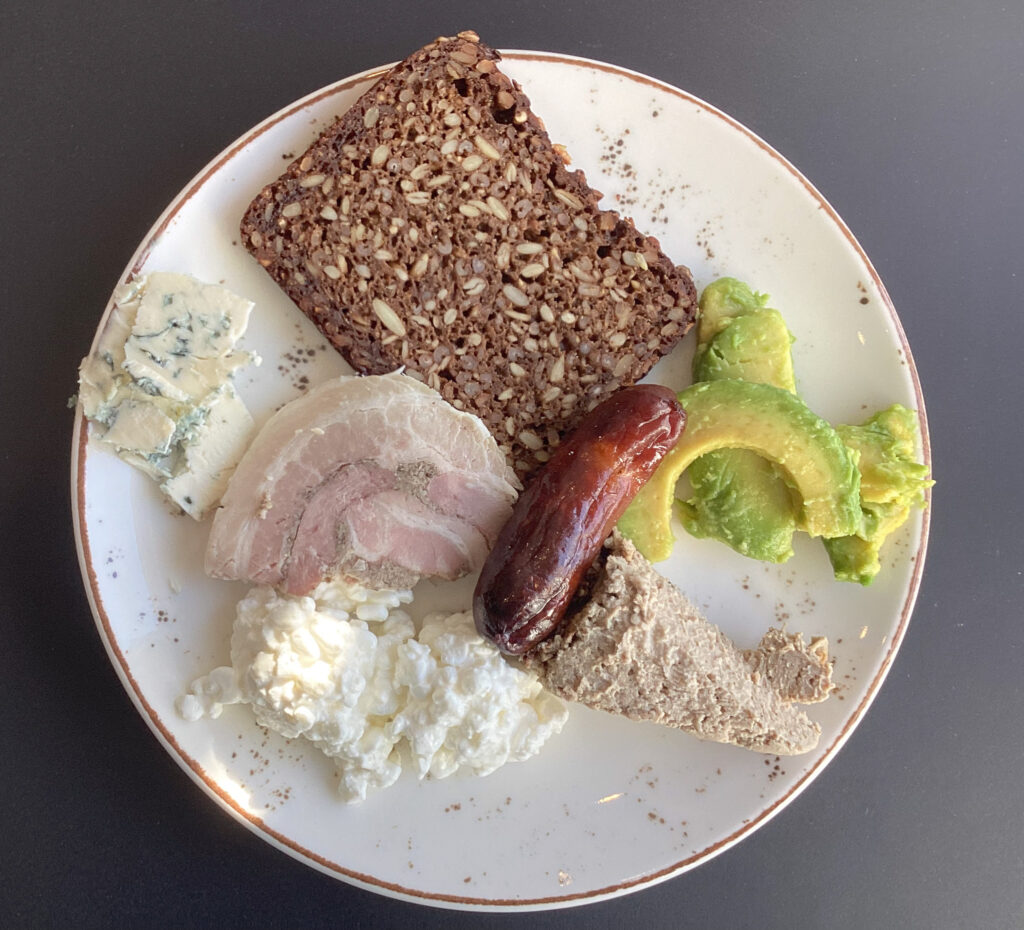
After our hearty Friday morning breakfast, I had a little shopping episode at the Gudrun Sjoden store which I had spied the day before. I’ve loved this Swedish company for decades but have only ever purchased goods from them online or from their mailed catalogues. Nature abhors a vacuum and there was room in my pannier that I needed to fill!!! While he waited for me to try on various combinations that the wonderful saleswomen kept bringing to me in the change room, John had a great chat with an eighty-year-old woman who happened to sit beside him in the waiting area. Somehow they identified each other as Cubase software users, John for recording musicians, and the woman for mixing everyday sounds together and laying them onto video. John’s 45 minute wait passed quickly and pleasantly. You never know what you may have in common with others!!!
Travellers’ tip: talk to people. It’s that simple.
Based on her recommendation, we visited the The Davids Samling Collection.
It is a museum of fine and applied art, built around the private collections of lawyer, businessman and art collector C. L. David. It reminded me, in a way, of the Frick Collection in NYC. The building that houses the museum used to be the private home of the founder and was originally bought in 1810 by his great-grandfather, C. N. David, but sold again in 1830. In 1917 it was re-acquired by C. L. David, who took up residence in it but also made his collection available to the public in the upper floors of the building. Admission is free. The museum is particularly noted for its collection of Islamic art from the 8th to the 19th century, which is one of the largest in Northern Europe. The museum also holds fine and applied art from Europe in the 18th century and the Danish Golden Age as well as a small collection of Danish early modern art. It was a sound recommendation from John’s octogenarian friend; we were grateful to her for it and glad that we put in the extra steps to get there.
However… we had a concert to walk to and it was 3 kilometres away, i.e. not downtown. The weather was iffy – grey, windy, so windy, and kind of spitty – but eventually we found our way (thank you Google maps) to DR Koncerthuset (Danish Broadcasting Corporation Concert House).
From Wikipedia: “The construction, begun in February 2003, was finished in January 2009. The Queen of Denmark inaugurated the venue. The complex, designed by Jean Nouvel, includes a concert hall with capacity for 1,800 people, and three recording studios with variable acoustics. The concert hall contains a pipe organ with 91 voices, 118 ranks, and approx. 6000 pipes, built by Dutch organ builders J. L. van den Heuvel. The main features of the building are a 4,000 m2 cable net façade and 500 m2 glass roof.” In my opinion, from the outside it wasn’t very impressive. Inside, however, is a different story.
Of course, during the building of the hall there were cost overruns. The budget was expanded several times due to the immense complexity of the project. In 2007 it reached $300M making Koncerthuset the most expensive concert hall ever built at the time. The current record holder for cost is the Elbphilharmonie (which we had seen in Hamburg!) The price tag for that was $836M.
Our meals at “KLANG” were delicious. We finished in time to stroll around the building itself and admire it. Then, the concert: it was absolutely stunning in musicality and technical difficulty. Hannigan’s singing and conducting were impeccable and thrilling. The hall is gorgeous, the sound is perfect, the orchestra was agile and produced a beautiful sound. It was a complex programme (the Gershwin arrangements were creative and tough!), and it was delivered flawlessly. It must have been a wild week of rehearsals to produce such a beautiful concert, but Hannigan has performed with this orchestra many times, so a good relationship exists already. The Danish couple sitting beside me were devoted Barbara Hannigan fans and said that she is very popular not only in Denmark but all through Europe. Good to hear, and well deserved!!! (Plus, she was just awarded the 2025 Polar Music Prize.) We, as Canadians, are very proud of this excellent artist.
Added bonus: after the concert, there is always a jazz trio (the piano is a Fazioli!); this evening’s jazz featured the orchestra’s Bb clarinetist who was very good and Hannigan herself sang a few tunes with the trio! (See photos.)
We walked the 3 km back to our hotel. It was still light, Copenhagen is a long way north, i.e. 55° N versus Toronto’s 44° – and fell into bed!
Saturday morning was ‘end of trip travel home day’. We (and our panniers, now a little fuller thanks to my shopping episode) jumped on a train to the airport, breezed right through security to the lounge and grazed there until we boarded. We had an uneventful flight home, watched an excellent documentary – The Engine Inside – check it out! – about cycling produced by Pon Bike, landed and breezed through Customs at Pearson, jumped on the UP Express to Union where we skipped into a cab, sat in a lot of traffic, and were in the door here by 5. HOME.
Spring 2025 trip: HIGHLY RECOMMENDED.
Thank-you for travelling with us. You can see our route for this trip, and the rough preliminary draft of our next trip – Amsterdam to the southwest end of England! – ambitious!!! – in the photo gallery, below. We’ve already bought our UK Visitors visas.
Patti and John
Jack Paddle on the Gripen Malmo, going from Sweden to Copenhagen, 1957
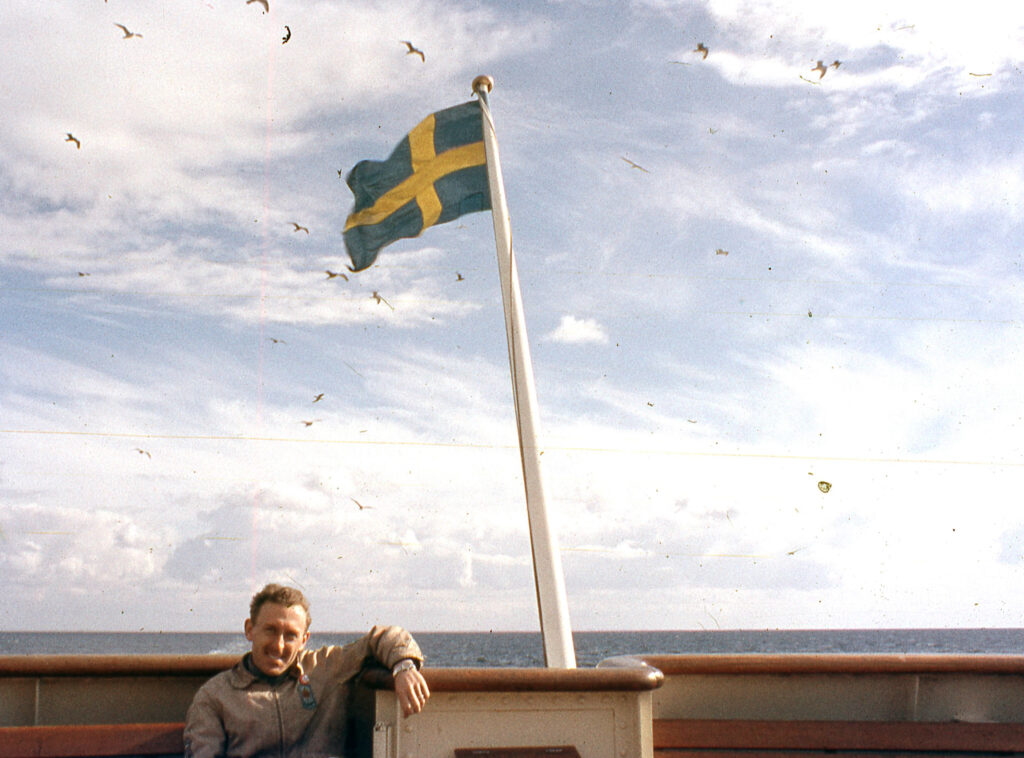
Patti and John on Air Canada 829, CPH-YYZ, May 31, 2025.
